Jira Software
Project and issue tracking
Content collaboration

Jira Service Management
High-velocity ITSM
Visual project management
- View all products
Marketplace
Connect thousands of apps and integrations for all your Atlassian products
Developer Experience Platform
Jira Product Discovery
Prioritization and roadmapping
You might find helpful
Cloud Product Roadmap
Atlassian Migration Program
Work Management
Manage projects and align goals across all teams to achieve deliverables
IT Service Management
Enable dev, IT ops, and business teams to deliver great service at high velocity
Agile & DevOps
Run a world-class agile software organization from discovery to delivery and operations
BY TEAM SIZE
Small Business
BY TEAM FUNCTION
Software Development
BY INDUSTRY
Telecommunications
Professional Services
What's new
Atlassian together.
Get Atlassian work management products in one convenient package for enterprise teams.
Atlassian Trust & Security
Customer Case Studies
Atlassian University
Atlassian Playbook
Product Documentation
Developer Resources
Atlassian Community
Atlassian Support
Enterprise Services
Partner Support
Purchasing & Licensing
Work Life Blog

Atlassian Presents: Unleash
Product updates, hands-on training, and technical demos – catch all that and more at our biggest agile & DevOps event.
- Atlassian.com
Customer Journey Mapping
Journey mapping helps you visualize how customers experience your product or service, and how they feel along the way. Scroll to step 6 for a real-life example from one of our product teams!
USE THIS PLAY TO...
Understand the customer journey from a specific persona's perspective so that you can design a better experience.

Running the play
Depending on how many touchpoints along the customer journey you're mapping, you might break the journey into stages and tackle each stage in pairs.
Sticky notes
Whiteboards.io Template
Define the map's scope (15 min)
Ideally, customer journey mapping focuses on the experience of a single persona in a single scenario with a single goal. Else, the journey map will be too generic, and you'll miss out on opportunities for new insights and questions. You may need to pause creating a customer journey map until you have defined your customer personas . Your personas should be informed by customer interviews , as well as data wherever possible.
Saying that, don't let perfect be the enemy of good! Sometimes a team just needs to get started, and you can agree to revisit with more rigor in a few months' time. Once scope is agreed on, check your invite list to make sure you've got people who know the details of what customers experience when using your product or service.
Set the stage (5 min)
It's really important that your group understands the user persona and the goal driving their journey. Decide on or recap with your group the target persona and the scope of the journey being explored in your session. Make sure to pre-share required reading with the team at least a week ahead of your session to make sure everyone understands the persona, scope of the journey, and has a chance to delve deeper into research and data where needed. Even better- invite the team to run or attend the customer interviews to hear from customers first hand!
E.g. "We're going to focus on the Alana persona. Alana's role is project manager, and her goal is to find a scalable way for her team to share their knowledge so they spend less time explaining things over email. We're going to map out what it's like for Alana to evaluate Confluence for this purpose, from the point where she clicks that TRY button, to the point where she decides to buy it – or not."
Build a customer back-story (10 min)
Have the group use sticky notes to post up reasons why your target persona would be on this journey in the first place. Odds are, you'll get a range of responses: everything from high-level goals, to pain points, to requested features or services. Group similar ideas and groom the stickies so you can design a story from them.
These narratives should be inspired by actual customer interviews. But each team member will also bring a different perspective to the table that helps to broaden the lens.
Take a look at the example provided in the call out of this section. This back story starts with the pain points – the reasons why Alana would be wanting something like Confluence in the first place.
- E.g., "Her team's knowledge is in silos"
Then it basically has a list of requirements – what Alana is looking for in a product to solve the bottom pain points. This is essentially a mental shopping list for the group to refer to when mapping out the customer journey.
- E.g., "Provide structure"
Then it has the outcomes – goals that Alana wants to achieve by using the product
- E.g., "To keep my team focused on their work instead of distracted by unnecessary emails and shoulder-taps"
And finally the highest-level goal for her and her team.
- E.g., "Improve team efficiency"
Round off the back story by getting someone to say out loud what they think the overall story so far is, highlighting the main goals the customer has. This ensures a shared understanding that will inform the journey mapping, and improve the chances that your team will map it from the persona's point of view (not their own).
- E.g., "Alana and her team are frustrated by having to spend so much time explaining their work to each other, and to stakeholders. They want a way to share their knowledge, and organize it so it's easy for people outside their team to find, so they can focus more energy on the tasks at hand."

For example...
Here's a backstory the Confluence team created.
Map what the customer thinks and feels (30-60 min)
With the target persona, back story, and destination in place, it's time to walk a mile in their shoes. Show participants how to get going by writing the first thing that the persona does on a sticky note. The whole group can then grab stickies and markers and continue plotting the journey one action at a time.
This can also include questions and decisions! If the journey branches based on the answers or choices, have one participant map out each path. Keep in mind that the purpose of this Play is to build empathy for, and a shared understanding of the customer for the team. In order to do this, we focus on mapping the current state of one discrete end to end journey, and looking for opportunities for improvement.
To do a more comprehensive discovery and inform strategy, you will need to go deeper on researching and designing these journey maps, which will need to split up over multiple sessions. Take a look at the variation below for tipes on how to design a completely new customer journey.
Use different color sticky notes for actions, questions, decisions, etc. so it's easier to see each element when you look at the whole map.
For each action on the customer journey, capture which channels are used for the interactions. Depending on your context, channels might include a website, phone, email, postal mail, face-to-face, and/or social media.
It might also help to visually split the mapping area in zones, such as "frontstage" (what the customer experiences) versus "backstage" (what systems and processes are active in the background).
Journey mapping can open up rich discussion, but try to avoid delving into the wrong sort of detail. The idea is to explore the journey and mine it for opportunities to improve the experience instead of coming up with solutions on the spot. It's important not only to keep the conversation on track, but also to create an artefact that can be easily referenced in the future. Use expands or footnotes in the Confluence template to capture any additional context while keeping the overview stable.
Try to be the commentator, not the critic. And remember: you're there to call out what’s going on for the persona, not explain what’s going on with internal systems and processes.
To get more granular on the 'backstage' processes required to provide the 'frontstage' customer value, consider using Confluence Whiteboard's Service Blueprint template as a next step to follow up on this Play.

ANTI-PATTERN
Your map has heaps of branches and loops.
Your scope is probably too high-level. Map a specific journey that focuses on a specific task, rather than mapping how a customer might explore for the first time.
Map the pain points (10-30 min)
"Ok, show me where it hurts." Go back over the map and jot down pain points on sticky notes. Place them underneath the corresponding touchpoints on the journey. Where is there frustration? Errors? Bottlenecks? Things not working as expected?
For added value, talk about the impact of each pain point. Is it trivial, or is it likely to necessitate some kind of hack or work-around. Even worse: does it cause the persona to abandon their journey entirely?
Chart a sentiment line (15 min)
(Optional, but totally worth it.) Plot the persona's sentiment in an area under your journey map, so that you can see how their emotional experience changes with each touchpoint. Look for things like:
- Areas of sawtooth sentiment – going up and down a lot is pretty common, but that doesn't mean it's not exhausting for the persona.
- Rapid drops – this indicates large gaps in expectations, and frustration.
- Troughs – these indicate opportunities for lifting overall sentiments.
- Positive peaks – can you design an experience that lifts them even higher? Can you delight the persona and inspire them to recommend you?
Remember that pain points don't always cause immediate drops in customer sentiment. Sometimes some friction may even buold trust (consider requiring verification for example). A pain point early in the journey might also result in negative feelings later on, as experiences accumulate.
Having customers in the session to help validate and challenge the journey map means you'll be more confident what comes out of this session.
Analyse the big picture (15 min)
As a group, stand back from the journey map and discuss trends and patterns in the experience.
- Where are the areas of greatest confusion/frustration?
- Where is the journey falling short of expectations?
- Are there any new un-met needs that have come up for the user type?
- Are there areas in the process being needlessly complicated or duplicated? Are there lots of emails being sent that aren’t actually useful?
Then, discuss areas of opportunity to improve the experience. E.g., are there areas in the process where seven steps could be reduced to three? Is that verification email actually needed?
You can use quantitative data to validate the impact of the various opportunity areas identified. A particular step may well be a customer experience that falls short, but how many of your customers are actually effected by that step? Might you be better off as a team focused on another higher impact opportunity?
Here's a user onboarding jouney map our Engaging First Impressions team created.
Be sure to run a full Health Monitor session or checkpoint with your team to see if you're improving.
MAP A FUTURE STATE
Instead of mapping the current experience, map out an experience you haven't delivered yet. You can map one that simply improves on existing pain points, or design an absolutely visionary amazeballs awesome experience!
Just make sure to always base your ideas on real customer interviews and data. When designing a totally new customer journey, it can also be interesting to map competitor or peer customer journeys to find inspiration. Working on a personalised service? How do they do it in grocery? What about fashion? Finance?
After the mapping session, create a stakeholder summary. What pain points have the highest impact to customers' evaluation, adoption and usage of our products? What opportunities are there, and which teams should know about them? What is your action plan to resolve these pain points? Keep it at a summary level for a fast share out of key takeaways.
For a broader audience, or to allow stakeholders to go deeper, you could also create a write-up of your analysis and recommendations you came up with, notes captured, photos of the group and the artefacts created on a Confluence page. A great way of sharing this information is in a video walk through of the journey map. Loom is a great tool for this as viewers can comment on specific stages of the journey. This can be a great way to inspire change in your organization and provide a model for customer-centric design practices.
KEEP IT REAL
Now that you have interviewed your customers and created your customer journey map, circle back to your customers and validate! And yes: you might learn that your entire map is invalid and have to start again from scratch. (Better to find that out now, versus after you've delivered the journey!) Major initiatives typically make multiple journey maps to capture the needs of multiple personas, and often iterate on each map. Remember not to set and forget. Journeys are rapidly disrupted, and keeping your finger on the pulse of your customer's reality will enable your team to pivot (and get results!) faster when needed.
Related Plays
Customer Interview
Project Poster
Want even more Playbook?
Drop your email below to be notified when we add new Health Monitors and plays.
Thanks! Now get back to work.
Got feedback?
Drop a question or comment on the Atlassian Community site.
Shared understanding
Different types of teams need to share an understanding of different things.
LEADERSHIP TEAMS
The team has a shared vision and collective purpose which they support, and confidence they have made the right strategic bets to achieve success.
Proof of concept
Project teams.
Some sort of demonstration has been created and tested, that demonstrates why this problem needs to be solved, and demonstrates its value.
Customer centricity
Service teams.
Team members are skilled at understanding , empathizing and resolving requests with an effective customer feedback loop in place that drives improvements and builds trust to improve service offerings.
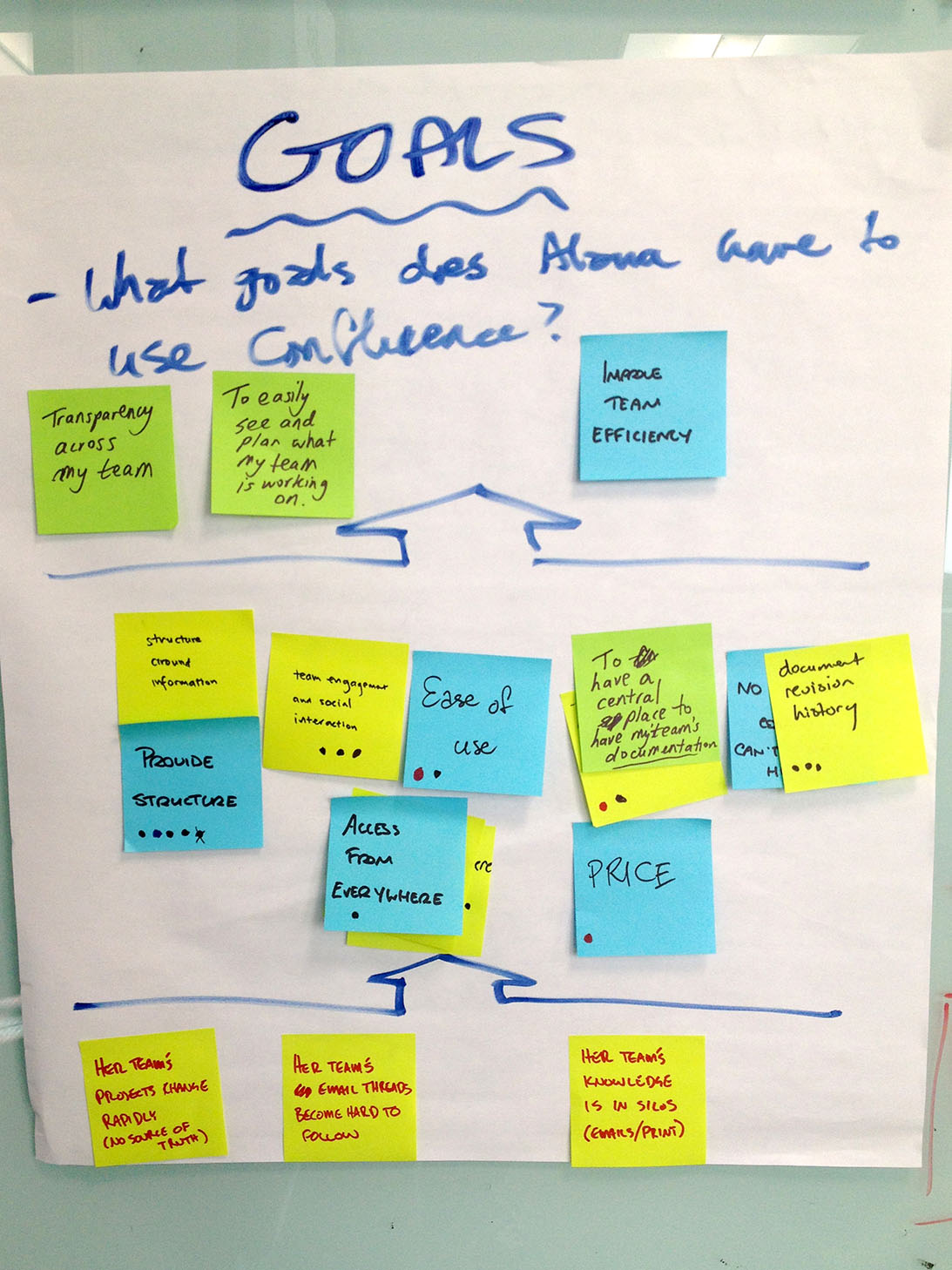

A comprehensive guide to effective customer journey mapping
A brand's user experience shapes its target audience's entire perception of your organization. Maximize audience engagement with customer journey mapping.

Discover key challenges today's marketing teams are facing, as well as opportunities for businesses in 2024.

Incorporating customer journey mapping into your web design process helps elevate consumer engagement to drive loyalty and sales.
Many in-house teams and web designers strive to better serve users by optimizing their customer experience (CX). Considering how your customers use your platform or service helps you see your website from a user perspective, letting you shape your design to better meet their needs. To achieve this, web designers can look to customer journey mapping.
A particularly handy tool for user experience (UX) design , this process helps teams understand who their users are and how to fulfill their expectations, guiding development decisions for improved audience engagement. Learn more about customer journey mapping and how you can implement it to enhance your CX.
User journey mapping: an overview
User journey mapping, also known as customer journey mapping (CJM), maps a website visitor's experience from their perspective. Presented through a visual diagram, the customer journey map charts the user’s path as they seek information or solutions, starting at the homepage and tracking their routes across other menus and links.
To create a customer journey map, you begin by researching who users are, what they want from your site, and how positive or negative their experiences have been.
There are two main purposes for mapping your customers’ journey.
1. Improve customer experience
This is the ultimate goal of CJM. Site navigation can be especially tricky to assess because you’re already familiar with the layout. A fresh perspective on your site often uncovers overlooked details such as navigation issues or broken links.
By conducting research on UX trends and visually mapping your results, you’ll identify any parts of your design that confuse or frustrate visitors. This process also reveals areas that work well, which you can repurpose elsewhere in the design.
2. Maintains ease-of-use as your site grows
A customer journey map can make even a simple site more straightforward to navigate. When your website or business grows, you may need to add content and features to accommodate the expansion. Implementing customer journey mapping ensures your website's fundamental flow remains intuitive and that new material and features are easily discoverable and usable.
Primary user journey map types
There are various ways to approach customer journey mapping based on the specific insights you’re seeking. The end result of each map will look similar, but the focus of each is different — which changes the information it offers. Here are three standard types of maps to get you started.
Current state
The current state map is the most common type. It evaluates your website’s present state to better understand visitors’ current experiences, helping identify improvement opportunities for its existing design.
Future state
A future state map explores a hypothetical "ideal" website, considering the visitor’s experience if every site component were optimized. This map is helpful when planning a total redesign or a specific change. When you collect user research and translate the results into your map, you can present a visual outline to your client or company for a straightforward explanation.
Persona-based
A persona-based map lays out the journey of a single designated type of user, or persona (which we will define below). This type of diagram is useful when optimizing your website for a specific sector of your audience with particular needs.

Learn best practices for integrating the workflows between design and development in this free webinar.
The 5-step customer journey mapping process
Once you’ve set clear goals for your map’s achievements, you can select the appropriate diagram type. To begin visualizing your user journey, follow this five-step process.
1. Define the map’s scope
Your map may focus on just one customer interaction or outcome, such as finding the newsletter sign-up sheet or making a payment, or it could cover the entire website’s navigation. A focused scope helps you troubleshoot a problem area or ensure an especially critical element functions properly. Alternatively, a larger-scope map provides a big-picture perspective of how the site works as a whole. Creating a comprehensive map is more complex, but high-level mapping helps comprehend the entire user experience from beginning to end.
2. Determine your user personas
A persona describes a particular type of visitor using your site. When imagining and defining these users, you can assign a name to each and include details about who they are, what they’re looking for, and why.
Focus on users who contribute most to your business goals, consulting your marketing or sales teams for insights. To define your customer personas, explore current user behavior through surveys, online reviews, and email list responsiveness.
For example, if you’re creating a website for a store that sells artisanal coffee-making tools, your personas could be:
- The gift giver. This user only knows a little about coffee but wants to select an impressive gift for someone else. They’ll need help with purchase decisions, so they might interact with an FAQ or chat feature before visiting the products page. They may also leave your site if overwhelmed by options, so it’s important to offer helpful information proactively. This will keep them engaged and more likely convert them to paying customers.
- The coffee nerd. This person is knowledgeable and always seeks the highest-quality tools, so easily accessible product details and customer reviews are important to them. To support their user experience and encourage them to purchase, ensure these elements are easily discoverable.
- The tourist. This user is on vacation and looking for a cute brick-and-mortar shop to visit. They aren't interested in your online store, but an appealing photo of your physical store with easily accessible hours and location information may convince them to come by in person.
These three types of users have very different needs and goals when visiting your website. To capture all of their business, create a map for each of them to ensure you accommodate their specific wants and circumstances.
3. Give the personas context
User context is the “when” and “how” of each persona visiting your site. A user will have a different experience loading your site on a mobile device than on a laptop. Additionally, someone in no rush may use your website differently than someone looking more urgently with a specific purpose.
Figure out when, how, and in what mindset your personas most commonly visit your site to map their experience accurately. This context has very concrete impacts on your finished design. If visitors tend to look for one specific page whenever in a hurry (like contact or location information), placing those details on the front page or prominently linking to it will smooth the user experience for those users.
Here’s an example of how to place a persona in context.
Persona: Jo is an apartment hunter in her early 20s and is still in college. She's looking for off-campus housing for herself and some roommates. The collective group values location and cost more than apartment features.
Context : Jo is in a hurry and trying to visit as many apartments as possible. She’s looking at property rental websites that clearly state apartment addresses in each listing.
Method : Jo is browsing the sites on her iPhone.
4. List persona touchpoints
Touchpoints mark when the user makes a purchase decision or interacts with your user interface (UI) . They include visitors' actions to move toward their goals and consider each associated emotion. The first touchpoint is how they reach your website — such as tapping a social media ad, clicking on a search result, or entering your URL directly.
First, list each action the visitor took and their corresponding emotional reactions. Subsequent touchpoints include instances when they navigate a menu, click a button, scroll through a gallery, or fill out a form. When you diagram the route through your site in an A-to-Z path, you can place yourself in the persona's mind to understand their reactions and choices.
A met expectation — for example, when clicking a "shop" button takes them to a product gallery — will result in a positive emotional reaction. An unmet expectation — when the “shop" link leads to an error page — will provoke an adverse reaction.
5. Map the customer journey
Illustrate the user journey by mapping these touchpoints on a visual timeline. This creates a narrative of users’ reactions across your entire service blueprint. To represent your users’ emotional states at each touchpoint, graph their correspondences like this:

The map helps you understand the customer experience as a whole.
For example, based on the diagram above, touchpoint 3 is the largest navigation challenge on the website. The graph also shows that the user's mood eventually rebounds after the initial setback. Improving the problem element in touchpoint 3 will have the biggest impact on elevating the overall user experience.
Customer journey mapping best practices
Now that you understand the mapping process, here are some best practices to implement when charting your customer journey.
- Set a clear objective for your map: Define your CX map’s primary goal, such as improving the purchase experience or increasing conversions for a specific product.
- Solicit customer feedback: Engage directly with customers through surveys or interviews so you can implement data-driven changes. Ask users about their journey pain points and invite both positive and negative feedback on the overall navigation.
- Specify customer journey maps for each persona: To specifically serve each customer persona, consider charting separate paths for each based on their behaviors and interests. This approach is more customer-centric, as not all user types interact with your website the same way.
- Reevaluate your map after company or website changes: As your business scales, your website must evolve — and so will your customer’s path. Review your map when making both large and small website adjustments to ensure you don’t introduce new user challenges. Navigational disruptions can frustrate visitors, causing would-be customers to leave your site and seek competitors .
Optimize your user journey map with Webflow
A user journey map is only as effective as the improvements it promotes. When redesigning your website based on insights your map provides, explore Webflow’s vast resource bank to streamline your design processes.
Webflow offers web design support with diverse guides , tutorials , and tools for straightforward web design. Visit Webflow today to learn how its site hosting , e-commerce , and collaboration resources support enhanced user experience for better engagement.
Webflow Enterprise gives your teams the power to build, ship, and manage sites collaboratively at scale.
Subscribe to Webflow Inspo
Get the best, coolest, and latest in design and no-code delivered to your inbox each week.
Related articles

What is customer experience? An essential guide
Learn why customer experiences are essential for your bottom line, and discover practical strategies to implement across your digital channels.

How to create marketing personas that start with empathy
Treating customers with respect earns you loyalty. Dig into marketing personas that reflect real people to gain the most valuable insight.
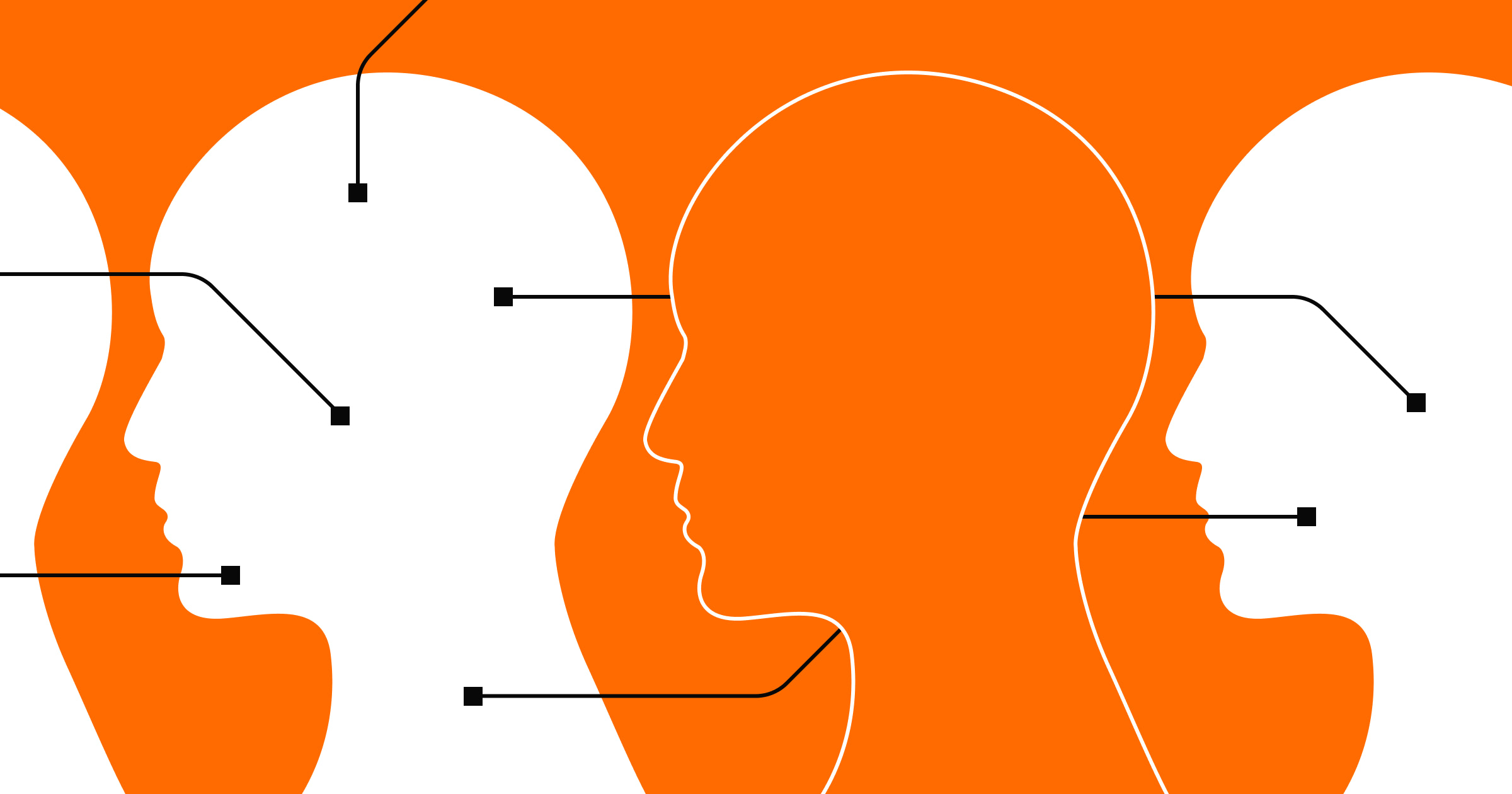
Elevate customer satisfaction with the power of AI personalization
Discover how different industries use AI personalization to improve customer experiences, and learn how to use hyper-personalization to maximize your marketing

How to implement and optimize effective customer-centric design
Implementing customer-centric design invites customers to collaborate with your brand and help shape truly unique products.

Multi-touch attribution models: A complete guide
Multi-touch attribution (MTA) enables you to assess multiple touchpoints to determine which ones are most critical in the path to purchase.

Keeping up with customer expectations in 2024
Tips for delighting your audience on the web in the new year
Get started for free
Try Webflow for as long as you like with our free Starter plan. Purchase a paid Site plan to publish, host, and unlock additional features.
Transforming the design process at
- Interactions
- Localization
- Figma to Webflow Labs
- DevLink Labs
- Feature index
- Accessibility
- Webflow vs WordPress
- Webflow vs Squarespace
- Webflow vs Shopify
- Webflow vs Contentful
- Webflow vs Sitecore
- Careers We're Hiring
- Webflow Shop
- Accessibility statement
- Terms of Service
- Privacy policy
- Cookie policy
- Cookie preferences
- Freelancers
- Global alliances
- Marketplace
- Libraries Beta
- Hire an Expert
- Made in Webflow
- Become an Expert
- Become a Template Designer
- Become an Affiliate
Skip navigation
- Log in to UX Certification

World Leaders in Research-Based User Experience
How practitioners create journey maps: typical uses, roles, and methods.

January 8, 2023 2023-01-08
- Email article
- Share on LinkedIn
- Share on Twitter
Customer-journey maps visualize a user’s journey towards a goal, usually over time and across channels .
In its most basic form, journey mapping starts by compiling a series of user actions into a timeline. Next, the timeline is fleshed out with user thoughts and emotions to create a narrative. This narrative is condensed and polished, ultimately leading to a visualization used to align stakeholders on the holistic experience and identify opportunities for optimizing and improving the journey.
Depending on context, existing resources, and project scope, the journey-mapping process can be approached in number of ways. We surveyed 343 practitioners who create and use journey maps in order to understand the following:
- What kinds of experiences are practitioners mapping?
- How does user research inform the journey-mapping process?
- Who is involved in creating journey maps?
- How do practitioners identify and align on journey-mapping components (e.g., actors and journey phases)?
In This Article:
What kinds of experiences are mapped, how does user research inform journey mapping, who is involved in creating journey maps, how are journey-mapping components identified.
Short answer: Journey maps are most frequently used to evaluate existing experiences. The majority of journey maps focus on active product (or service) usage or end-to-end customer journeys.
Journey mapping can be used as a process to evaluate and optimize existing products or services or as a visioning exercise for future-state experiences with products and services that don’t exist yet.
Our research indicates that, most frequently, practitioners use journey mapping to explore products and services that already exist — either to evaluate the current experience of those existing products (89%) or to envision optimized, future-state experiences with existing products (73%). Still, over half or respondents (61%) indicated that they also use journey mapping to brainstorm future-state experiences with potential new services or products that do not yet exist.

Journey maps can be used to evaluate experience at the customer-relationship and -lifecycle level or they can zoom in to explore activities related to specific goals.
Our research indicates that, while practitioners use journey maps to explore various types of journeys, from presales experiences to purchasing and onboarding, active product or service usage and end-to-end journeys are the most frequently explored (71%). Support receives the least attention: only 26% of respondents indicated they use journey maps to understand these types of journeys.

Short answer: Most practitioners employ a hypothesis-first approach. User interviews are the most utilized method; diary studies are the least.
When creating a journey map, there are 2 high-level approaches for how to begin.
- The research-first approach begins with a designated period of primary user research led by the UX or design team; the research is later consolidated into a map.
- The hypothesis- or assumption-first approach begins with a workshop where a crossfunctional team makes use of existing knowledge in order to create an assumption map or hypothesis map.
The majority of practitioners (62%) use a hypothesis-first approach, relying on already existing knowledge held by team members or stakeholders to being the mapping process. About a third (35%) of practitioners begin the mapping process with an upfront user-research phase.

Beginning a journey-mapping project with a hypothesis-first approach often makes sense for teams who need to lower the entry barrier to mapping and get multiple parties engaged, move quickly due to a condensed project timeline or limited resources, or who have existing research insights available and do not need to invest in extensive upfront research.
If you begin with a hypothesis-first approach to build buy-in with stakeholders, we recommend following up this stage with user research to validate or evolve assumptions and create a second version of the map that integrates primary user-research findings.
When it comes to specific research methods for journey mapping , interviews are the most utilized method — 86% of respondents used them for external user research and 76% for internal stakeholder research.
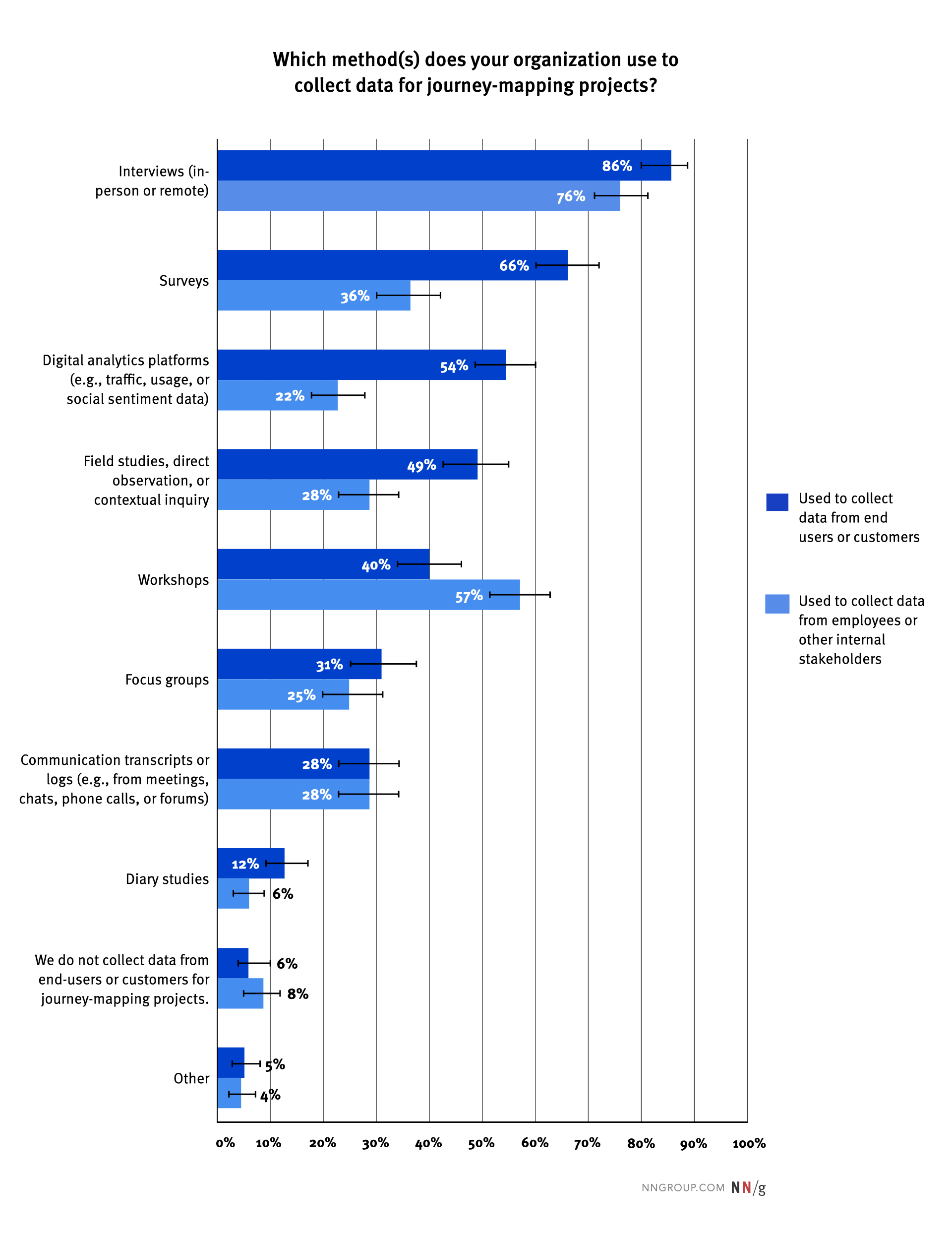
Interviews are generally a great research method for informing journey maps: They reveal first-hand stories about customers’ experiences, mindsets, and actions, and they are usually easy to conduct and flexible in format (e.g., can be conducted remotely or in person).
Diary studies are utilized the least — only 12% of respondents reported using them for external research and 6% for internal research. That’s a shame. Because customer journeys happen over time and across many different channels, diary studies are a particularly useful method for understanding users’ thoughts, feelings, and actions over time. They can be coupled with user interviews to better understand key milestones and more in-depth attitudinal data.
Short answer: Most journey maps are cocreated by a team of multidisciplinary roles who contribute and collaborate via physical or digital tools.
In our study, UX or design roles were most commonly indicated as either leads or contributors for journey-mapping projects. Of course, our sample population is highly biased, as we recruited from our own audience of readers.
What’s more interesting is the fact that journey mapping is typically a highly collaborative process, frequently involving crossdisciplinary roles from product, marketing, and customer service or support, 70%, 46%, and 42% of the time, respectively.
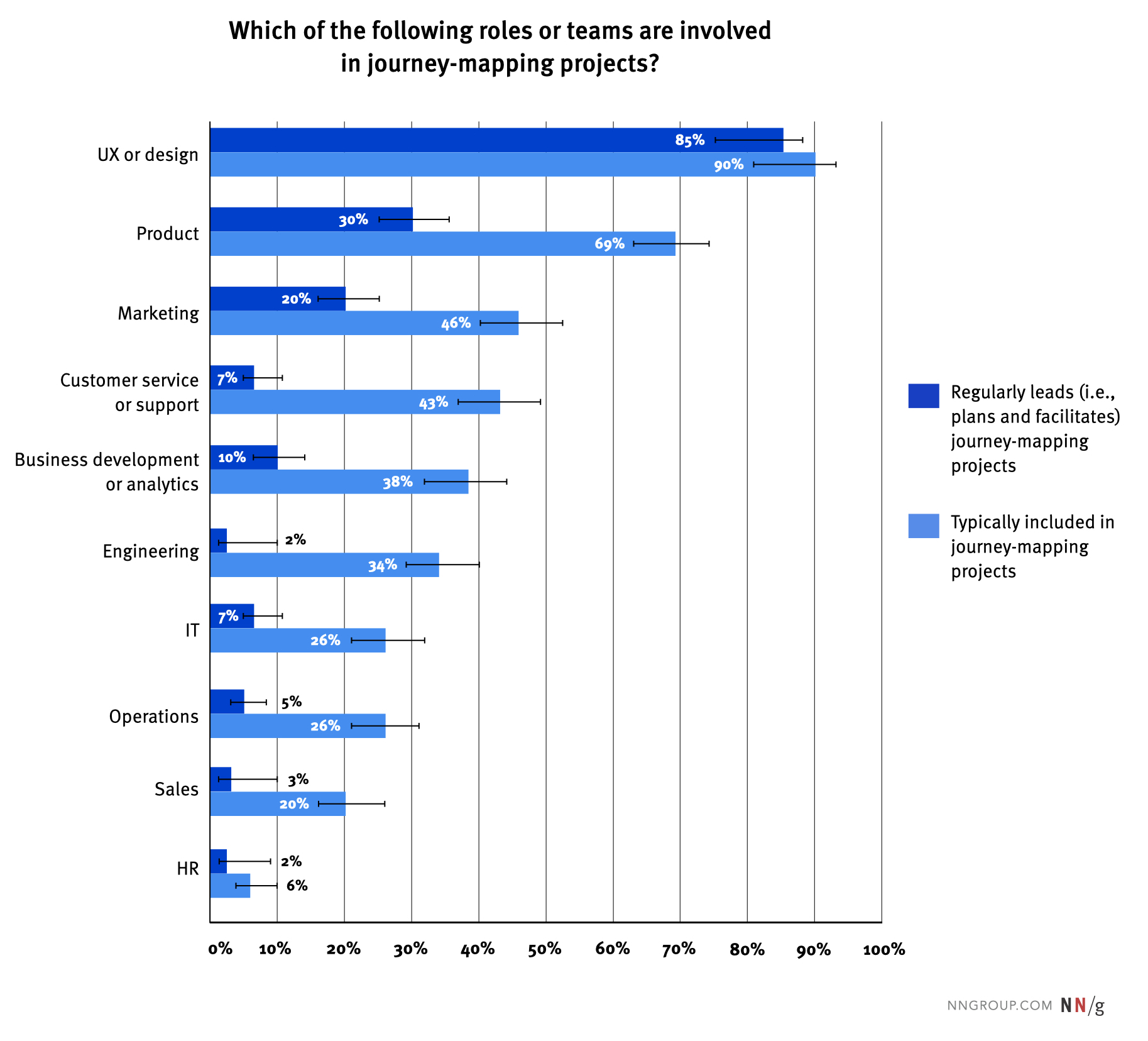
Involving representatives from various departments or lines of business is a smart approach. These groups often have ownership and vested interest in the success of segmented portions of the customer journey. Bringing them together builds collective knowledge and a more comprehensive understanding of existing pain points and opportunities.
In addition, most practitioners (64%) reported creating the journey maps collaboratively, with 34% collaborating over physical tools (e.g., sticky notes and paper) and 30% using digital tools (e.g., Miro, Mural, Google Sheets). In contrast, 36% reported creating the map as a solo activity using either physical tools (10%) or digital tools (26%).

Short answer: Existing personas are often used as actors, while journey phases are creating during the mapping process.
Journey maps rely on certain components to organize the narrative and ensure that the artifact is easy to understand and process. These components can be identified either at the initiation of the journey-mapping project or during key milestones within the journey-mapping process, such as research phases and workshops.
One component is the actor, which generally aligns to a user group or persona and helps answer the question, “Who is this journey map about?” Most of our respondents (49%) used existing personas for their journey-mapping projects. Less than a third (27%) developed personas as a part of project-related user research and even fewer (14%) created personas during a project-related workshop phase.

Another component is the set of journey phases that describe journey subgoals and help organize the doing, thinking, and feeling content within the map. In contrast to the actor, most respondents reported that they did not begin the journey-mapping process with phases identified; instead, they either identified them during user research (31%) or during a workshop (31%).
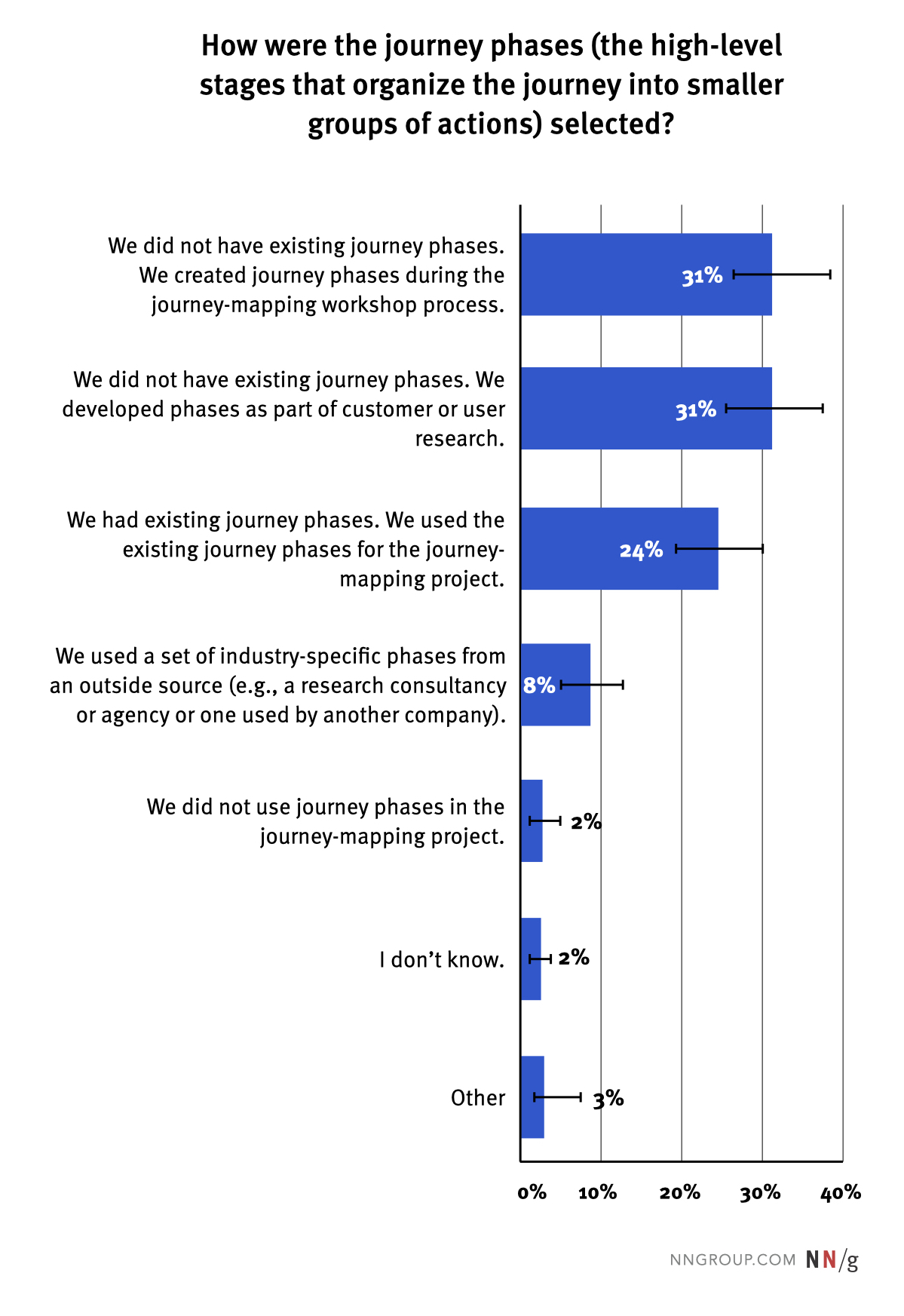
This finding is not surprising; while some larger organizations might start with a strawman set of phases borrowed from a marketing or sales lifecycle, it is also appropriate to let phases emerge as internal knowledge consolidates and external research reveals unknown gaps.
While there are varied ways to shape and conduct journey-mapping projects, our research indicates some common trends.
During journey-mapping projects, practitioners in our study typically:
- Used journey mapping to understand the experience of existing products and services
- Relied on interviews as a primary research method
- Used a collaborative process to create journey maps
- Involved contributors from multiple departments
- Used existing personas for their maps
- Created journey phases during the mapping process
If you’re determining the appropriate approach for a specific journey-mapping project, consult the following resources:
- How to Conduct Research for Customer Journey-Mapping : 5 types of research methods appropriate for journey mapping and how use them together
- Journey Mapping: 2 Decisions to Make Before You Begin : When to use an assumption-first approach vs. a research-first approach, and when to use current-state vs. future-state journey maps
- The 5 Steps of Successful Customer Journey Mapping: 5 high-level steps to journey mapping and how to scale them for your project scope and timeline
- How Much Time Does it Take to Create Customer Journey Maps? : Data for understanding and estimating the time and cost involved in the journey-mapping process
Related Courses
Journey mapping to understand customer needs.
Capture and communicate UX insights across complex interactions
Facilitating UX Workshops
Lead goal-based group activities to make decisions and establish alignment
Leading Highly Effective UX Teams
Build and manage a successful user experience team
Related Topics
- Design Process Design Process
Learn More:

Journey Mapping: 2 Decisions to Make Before You Begin
Kate Kaplan · 3 min

Scenario Mapping for Design Exploration
Kim Salazar · 3 min

Customer Journey Mapping 101
Sarah Gibbons · 2 min
Related Articles:
Journey Mapping 101
Sarah Gibbons · 7 min
When and How to Create Customer Journey Maps
Kate Kaplan · 6 min
User Experience vs. Customer Experience: What’s The Difference?
Kim Salazar · 5 min
Hiring and Retaining UX Teams During the Great Resignation
Evan Sunwall · 12 min
The 5 Steps of Successful Customer Journey Mapping
Why Map in Discovery: 3 Mapping Methods
Maria Rosala · 7 min
- Get Out Of Dark
- Creating CJM
- Improving CX
- Expert advice
- Online Marketing
- Marketing OPS
- Consultants

Imagine you have a company and you’re trying really hard to acquire new customers doing a ton of marketing activities – you’re active on all possible social media accounts (each with a different type of content), you sponsor some of your social media posts to make sure they reach your target audience, buy some podcast ad reads, sponsor a few influencers, have some billboards around the city, a corporate blog where your luckiest employee is forced to write something every week, have a nice once-a-month newsletter, an active boss attending events and handing out his new shiny business cards, your online store promo codes in a magazine ad, a contest where the winner gets that coffee machine your company got last Christmas from your biggest vendor, organize come-and-see for High School students in the vain hope they will talk about it with their parents, … and that’s enough for our example.
We intentionally listed all basic marketing channels we could think of to make you say “Who the heck can make sense of this? It’s a total mess. Nobody can possibly know how it all fits together and make sure all these customer touchpoints/activities are pointed towards their goal (acquiring a customer), while recognizing their unique form and different ways they’re approached or consumed by customers.” Okay, maybe you thought just the first part about it being a mess, but you get the point.
Now let’s take one of the journeys (ways) a potential customer can take.
When a potential customer spots the billboard, he’ll probably not buy from you instantly – the billboard will point him somewhere – to the website with an online store, to one of the social media accounts, or maybe to your store. One customer journey here would be: potential customer sees the billboard → visits the website → is intrigued by the seasonal sale → buys. But it’s not always this straightforward – there could be a pre-order of something you don’t yet have available for sale in your online store and the potential customer only wants to buy it when it’s in stock. What then? There has to be another fictional customer journey to accommodate this scenario: potential customer sees the billboard → visits the website → signs up for a newsletter so he’s informed when the super hot new thing from pre-order is available.
The more marketing activities you have, the more combinations of various scenarios become possible, and, well, the bigger the mess is. Imagine there are 30 more combinations like this.
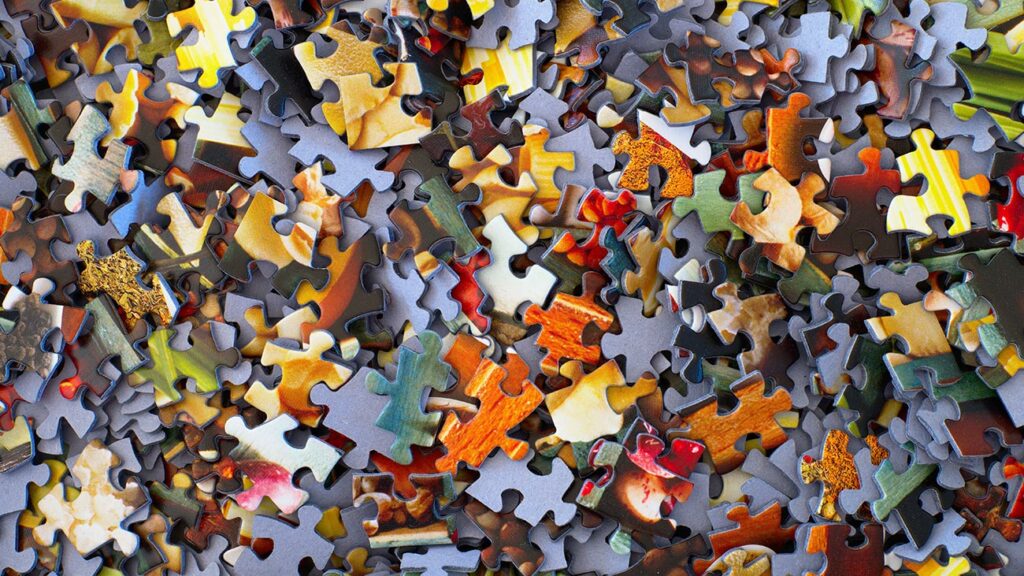
And that’s where a customer journey map comes in – to infuse some order into this mess. You put together all customer touchpoints/activities/channels and sort them into multiple phases. You won’t simulate every possible way customer can take to purchase your product – it’s enough to only outline all the “stops” he can make on his journey.
Not every activity has to convert a potential customer into an actual customer instantly (like we’ve demonstrated in our example above), but it can move him closer or give him an easy way to becoming one in the future. It’s almost a given that in the process of putting together a customer journey map you will suddenly realize some new relationships between your marketing activities and how you can take advantage of them.
Writing this down in a text document would be torture, and it would be an even bigger torture to navigate. That’s why a map (very often visual, or at least with some visual elements) is created – to illustrate all the touchpoints/activities/marketing channels. While most of its contents are pretty straightforward, there are some that marketers often forget to include in their customer journey maps .
While a customer journey map is a very powerful tool, it’s not a band-aid to treat the elements of a poor marketing effort – but creating it can at least provide you a framework for understanding where your marketing is lacking and addressing these areas. It will also help you to see at which stages are your potential customers leaving the journey and not coming back.
If the pieces of your marketing strategy are already in place and properly executed, creating a customer journey map will help you amplify their effect. Besides the marketing itself, the customer journey map has a very practical use case in your team, too: everybody will know what’s going on and anyone can be instantly brought up to speed – this is especially useful when you’re about to welcome a new team member. You can significantly cut the just-sit-here-and-please-try-to-understand-what-we’re-actually-doing-here phase and simply point to the map.
So, what next? We prepared this simple step-by-step guide to help you create your first customer journey – make sure to check it out. When you’re done, you’ll certainly know what to do next!
Do you want to create an interactive and easy-to-use customer journey map with powerful touchpoints, personas, automatic KPI import & monitoring, and much more?
Related articles, the problem with using spreadsheets for customer journey mapping (do this instead), why miro, figma, clickup, or lucidchart aren’t good for cjm (+ the alternative), 7 things to avoid in customer journey mapping, how see, think, do, care phases work in cjm.

How to understand, use, and build customer journey maps
A customer journey map is key to building a solid marketing strategy. We cover everything you need to know about customer journey maps, their different types, examples, and the steps to making your own.
What is a customer journey map?
Why do you need a customer journey map, characteristics of customer journey maps.
- What are touchpoints?
- Different types of customer journey map
Journey map variations
- How to create a customer journey map
Customer journey map tools
- How to build an empathy-based, data-backed customer journey map
- How to use empathy to create stronger customer journey maps
- Customer journey tools: Top rated and best available
The customer journey is a long and often unpredictable road. Understanding it can be even more complicated.
That’s why customer journey maps were invented: to understand the roadmap of a customer, from the very first touchpoint throughout the lasting life of their relationship with your business.
Customer journey maps (or user journey maps) can be an invaluable resource for companies, from marketing to sales to UX, and are known to help businesses increase their ROI by 13–22% if done correctly.
Below we cover journey maps from top to bottom, their importance, characteristics, and review examples, along with what you need to make your own.
Key takeaways:
Customer journey mapping is a strategic (and successful) approach to truly understanding your customers.
There are real and valuable business reasons to journey map.
There are six basic types of customer journey maps.
Customer touchpoints are every instance of interaction or engagement that happens along the journey.
There are current- and future-state customer journey maps that can help predict future behavior.
A customer journey map (sometimes called a user journey map, UX map, or CJM) is a visualization of the steps and experiences a customer has with a brand, from first contact to ongoing engagement, revealing both seen and unseen interactions.
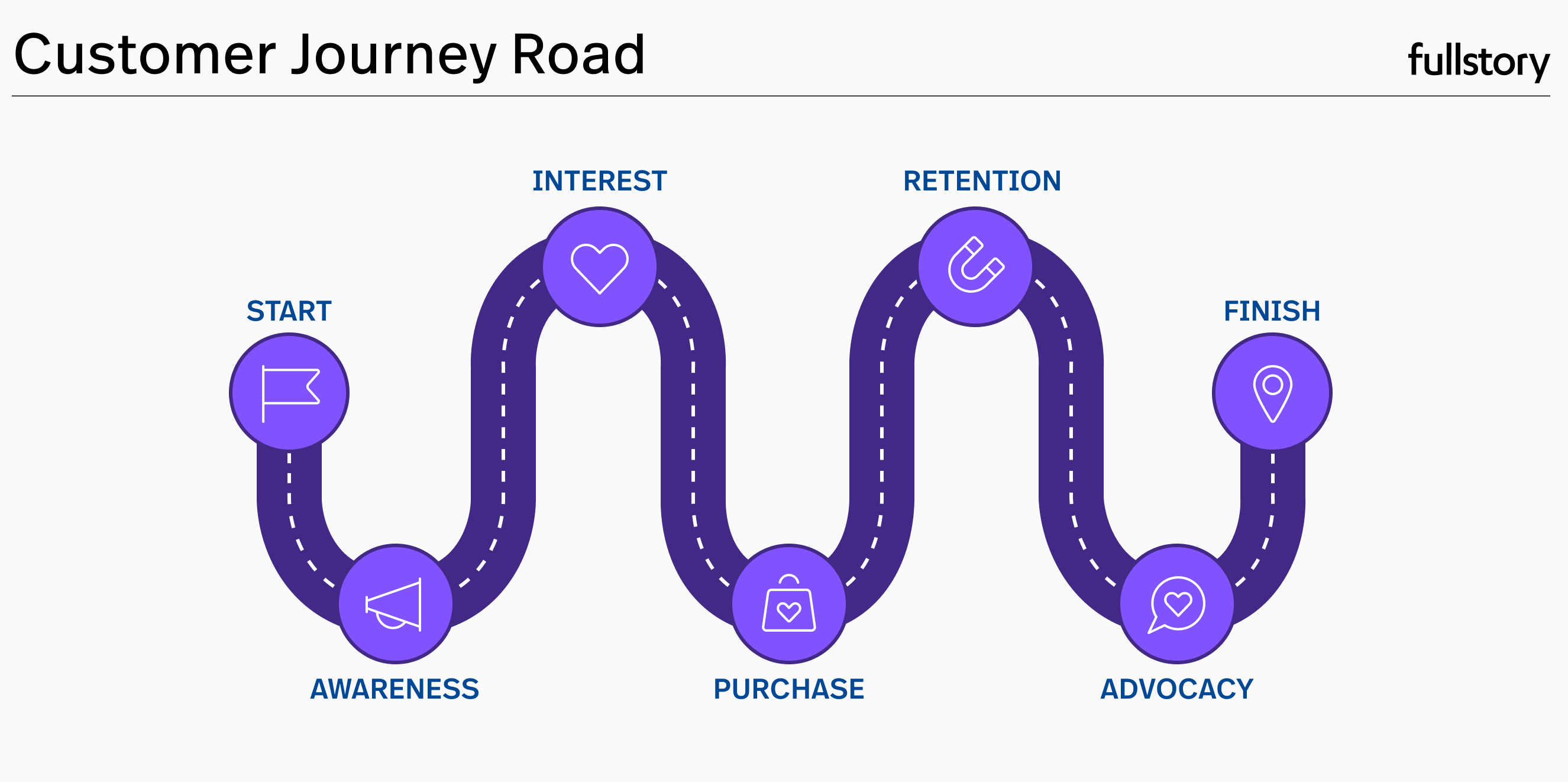
User journey mapping lets you create personalized experiences across all touchpoints —for every individual—across all channels.
Companies can use this shared understanding to identify opportunities for innovation and improvement.
These maps can be simple or complex, depending on what you're looking to gain from them.
For any company, a customer journey map helps to enhance the customer experience and increase customer loyalty.
A customer journey map can prove invaluable for optimizing across multiple departments—marketing, sales, product, and customer service—in many, many ways. Mapping your customer journey can help you:
Promote a customer-centric culture internally and externally
Identify your ideal buyer and connect with customer needs
Glean customer journey insights into your audience that can drive revenue
Improve sales funnels & conversion rates authentically
Amplify customer experience by understanding the customer’s perspective
Reduce customer support tickets by locating customer pain-points
Aid in marketing campaigns
Generate repeat business
Decrease customer churn and increase customer lifetime value
Together, these advantages translate into higher sales for your business.
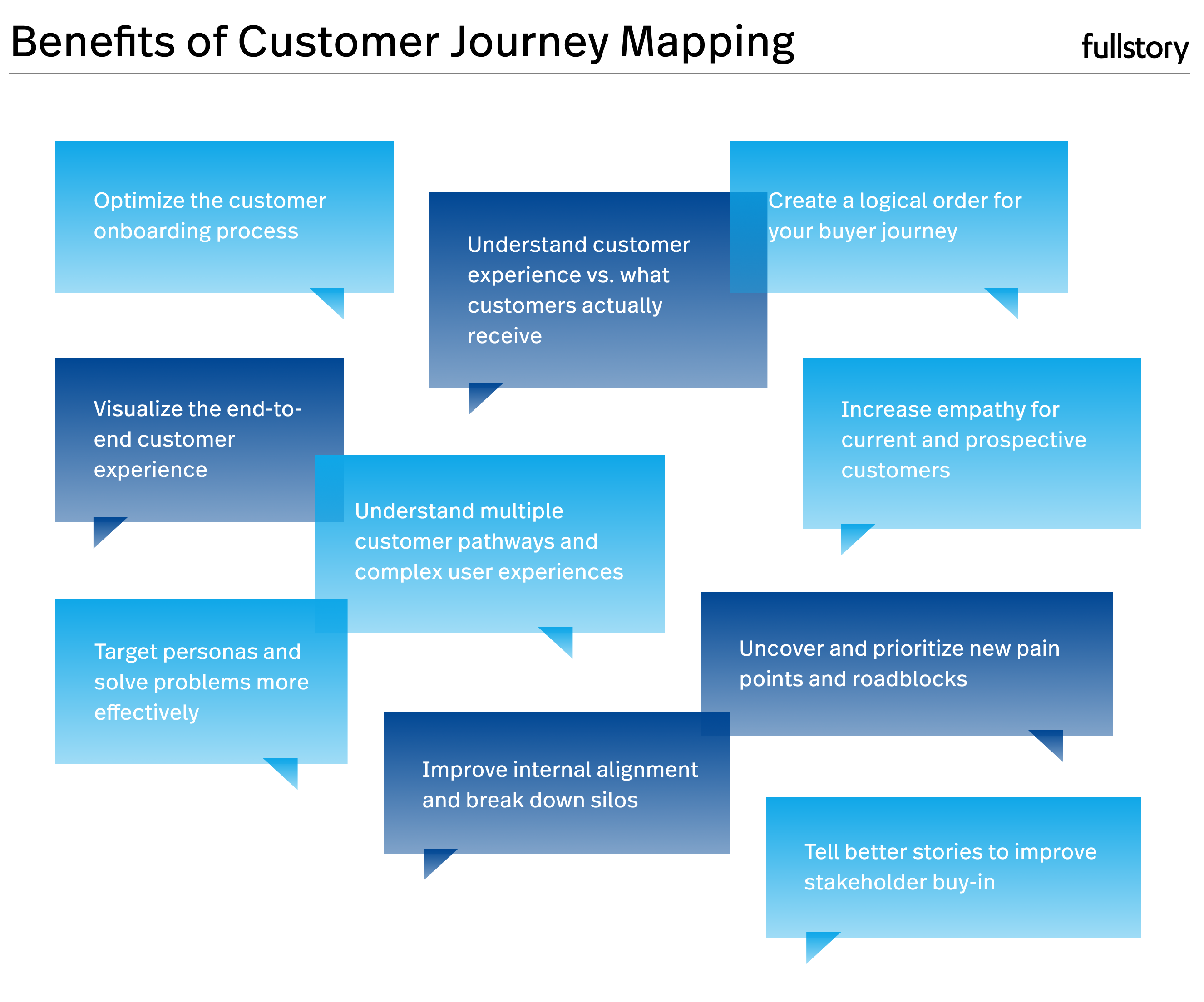
A typical customer journey map includes:
Actors—or potential profiles of customers—usually align with personas and their actions in the map are rooted in data . These actors will be the foundation of your map, and they will dictate the actions needed to create the desired outcome.
Customer personas and buyer personas: What’s the difference?
A buyer persona is a profile that showcases your ideal customer based on existing customer data and market research. Buyer personas help humanize the ideal customer you are trying to attract, which helps you understand them better and pick the right marketing strategy to convert them.

A buyer persona is your ideal customer—they’re in research mode. You can have more than one buyer persona for your company, and understanding this buyer is the key to creating a successful customer experience. This buyer will turn into your customer.
Here’s what makes up your buyer persona:
Demographics —including personal, professional, and specific (age, gender, location, education, income, marital status, skills, routines, etc.)
Goals —including personal and professional, priorities, and challenges
Values —including personal and professional, and what they find to be important in products and companies
Preferences —including the content they consume, their communication choices, communities, groups, or associations, and how they spend their day, on and offline
All of these characteristics make up customer journey maps on the buying path.
Journey phases
Journey phases are the different high-level stages in the customer roadmap. They provide organization for the rest of the information in the journey map (actions, thoughts, and emotions).
The stages will vary from scenario to scenario, and each organization will usually have data to help it determine what these phases are for a given scenario. Often you will see awareness, research, evaluation, and decision making in the customer phases.
Customer expectations
Journey maps are best for scenarios that involve a sequence of events, describe a process, or might involve multiple channels.
Pain points are a specific problem that customers or prospective customers of your business are experiencing in the industry.
Scenarios can be real (for existing products and services) or anticipated—for products that are yet in the design stage.
Actions, mindset, and sentiment
Every customer has a particular action that they take, because of a mindset that they have and will express it in their own sentiment.
Actions: When a customer engages with your brand with a purpose.
Mindset : Correspond to users' thoughts, questions, motivations , and information needs at different stages in the journey.
Emotions : How customers feel about your brand, whether positive, negative, or neutral. Plot these emotions in a single line across the journey phases, signaling the emotional highs and lows of the experience.
Opportunities
Opportunities of a customer journey map are desired outcomes. Maps should include key components, which can depend on the goal of the user journey mapping initiative.
Opportunities are also insights gained from mapping—they speak to how the user experience can be optimized.
To create a customer journey map, identify the personas, map the triggers that lead to desired outcomes, and discuss opportunities.
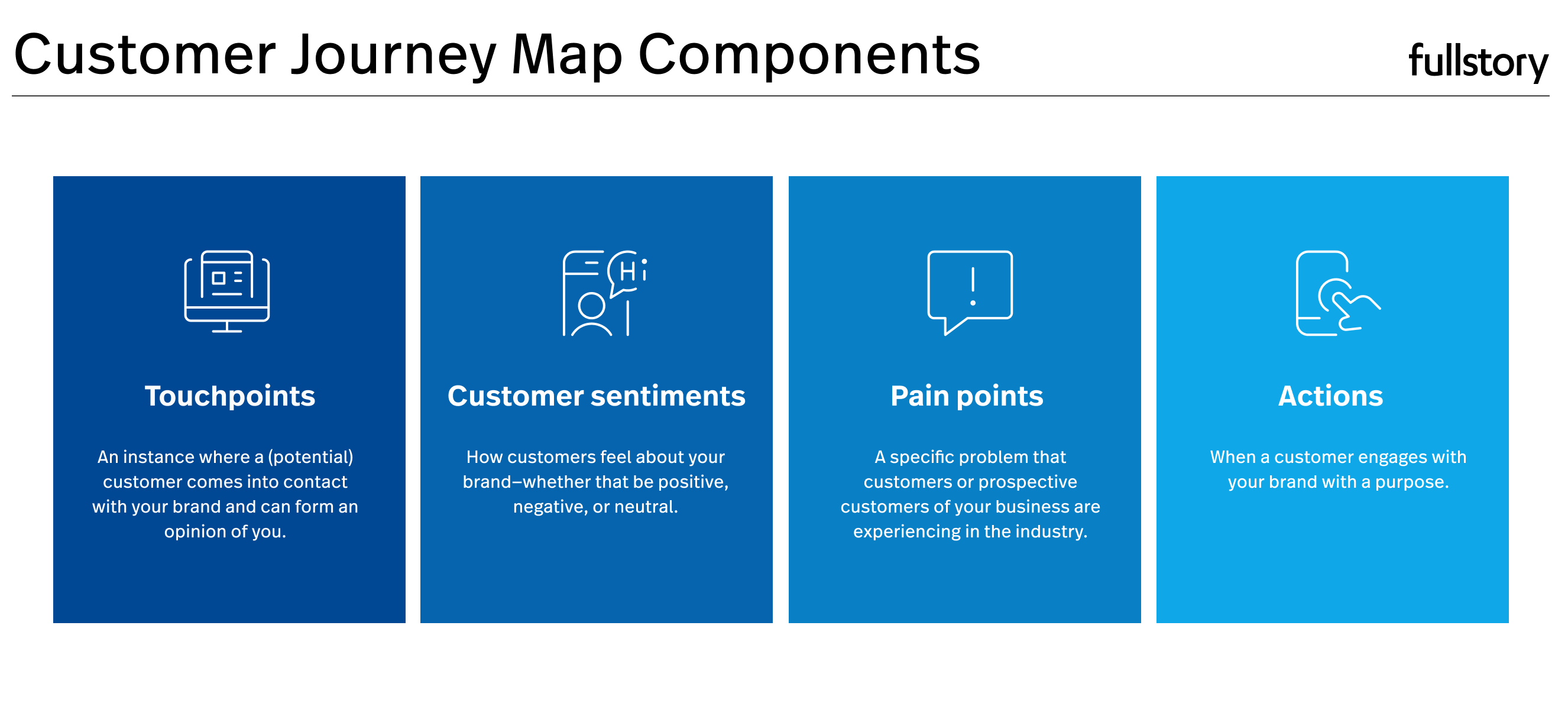
What are customer journey touchpoints?
Customer journey touchpoints are individual transactions through which the customer interacts with a business.
Customer journey touchpoints for omnichannel brands are everywhere, here are a few examples:
Social media posts
Product demos
Advertisements
Brick and mortar visits
Website visits
You’ll also have the added returning customer touchpoints to consider—like how engaged they are with your product, if they are returning to your website or if they are attending your events for the second or third time.
Examples of customer touchpoints
Identifying each touchpoint is crucial for creating a customer journey map that will drive a better customer experience. Once you’ve identified the touchpoints, list out possible customer actions for each.
Some actions that derive from customer touchpoints might be:
Downloading an eBook
Clicking on your FAQ
Requesting a demo or call
Subscribing to your blog
Clicking a paid ad
It’s important to know which touchpoints to invest time and resources into. Your map maps out the areas you can improve, retain and scale.
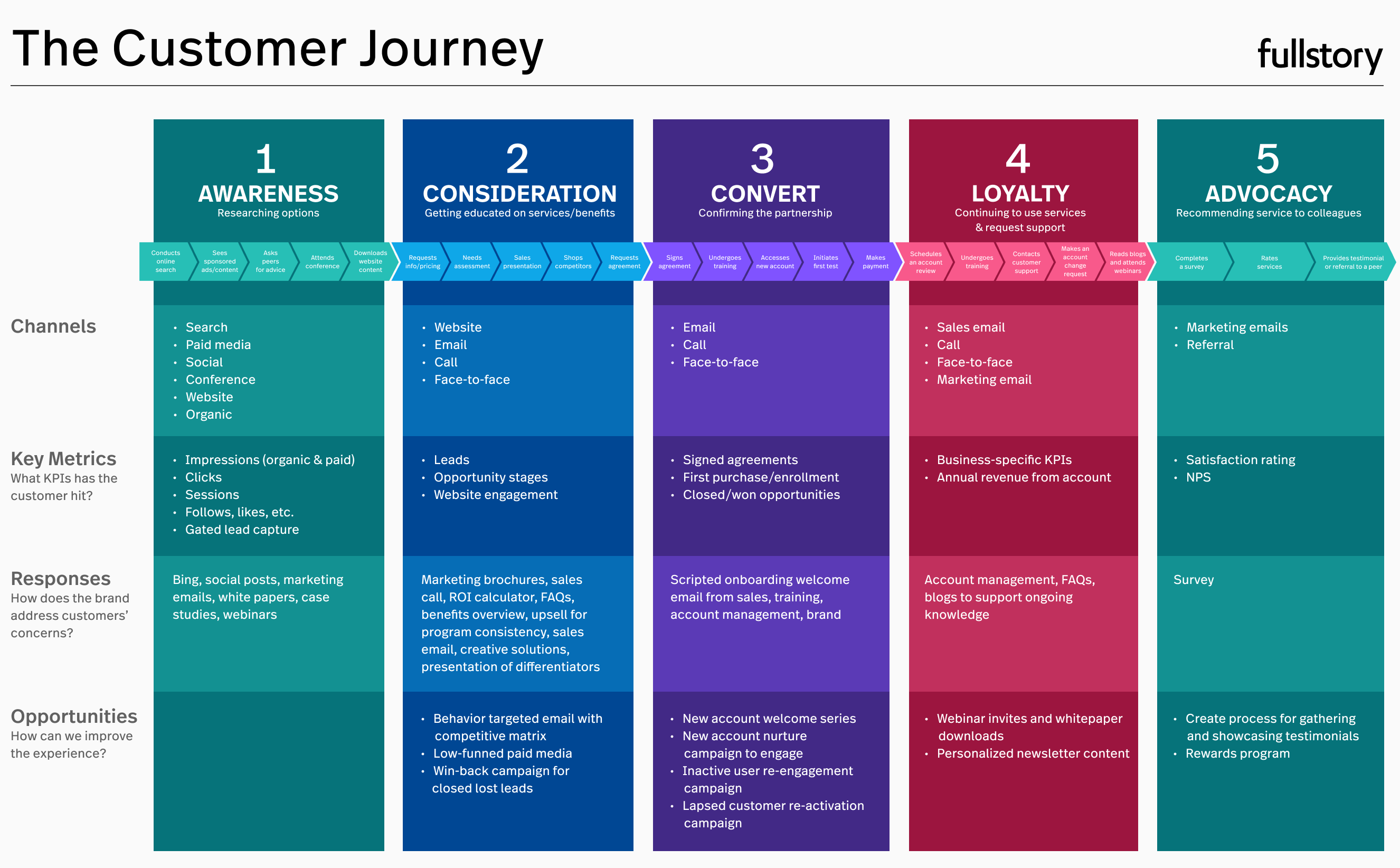
Types of customer journey maps
Each customer journey map has a different objective and business focus. There are six types to familiarize yourself with:
Current state —These illustrate what customers do , think, and feel as they interact with your business currently.
Future state —These illustrate what customers will do, think, and feel as they interact with your business in the future.
Day in the life —These examine everything that customers or prospects do, think, and feel (within a specific area), whether that involves your product or not.
Service blueprint —This is a diagram that usually starts with a basic version of an existing or future state journey map.
Circular —These are used for subscription-based models to visualize the customer journey as a circle or loop. This helps reinforce the importance of customer retention and lifetime value.
Empathy —These are used to create a shared understanding around the wants, needs, thoughts, and actions of a customer.
Journey maps are meant to be used as a strategic planning tool. Use these definitions to guide you towards aspects of other methods that your team has not previously considered.
Journey map vs. Experience map
A journey map is specific to a product or service, while an experience map is more general and can be used outside of a business's scope.
Since experience maps are more generic in nature, they can also be used to find pain points in a product or service for a future journey map.
Journey map vs. Service blueprint
If journey maps are a product of experience maps, they will need a blueprint to direct them there.
Service blueprints are a continuation of journey maps in the service industry. They lead the roadmap for service-based customer journeys.
Journey map vs. User story map
User stories are used in Agile to plan features or functionalities, much like a future customer journey map.
In the user story map case, each feature is condensed down to a deliberately brief description from a user’s point of view. The typical format of a user story is a single sentence:
“As a [type of user], I want to [goal], so that [benefit].”
How to create a customer journey map
To create a customer journey map , it helps to have an idea of the steps involved. You can break the process of creating a customer journey map down into the following steps:
Define —Define your map goals with the customer’s journey in mind and your business goals at the finish line.
Describe —Describe your customers and personas in detail from all aspects of their lives.
Determine —Identify customer touchpoints from the beginning of the roadmap of engagement with your brand.
Design —Lay out the customer journey every step of the way.
Designate —Mark customer milestones, motivations, frustrations, and turning points .
Decide —Flag events that require action and make the necessary arrangements to fix any errors.
Deploy —Adjust and optimize for a smoother customer experience.
Customer journey map templates
Having a template is a great way to get started. There are a few different templates to choose from:
Current state customer journey map
The current state journey map visualizes the current experience with your product or service. It involves defining the scope of the customer experience with customer touchpoints.

This type of customer journey map is designed with the considerations, thoughts, feelings, and actions of your customers in mind. Current state mapping is a practical approach to identify existing pain points and create a shared awareness of the end-to-end customer experience.
Day-in-the-life customer journey mapping
A day-in-the-life journey map is another simple grid map based on time, created especially for the daily grind of the customer. Instead of different journey stages, it represents times in the day related to actions based on decisions in the path of purchasing.
This template helps you visualize your customer’s daily routine even if these actions are outside your company. It typically is organized chronologically to systematically show the course of the habits of the day.
Day-in-the-life's are great for giving you insights into all the thoughts, needs, and pain points users experiences throughout their day. You can use this type of map to evaluate when your product or service will be most valuable in your customer’s day.
Future-state customer journey map
With a future-state journey map template, your goal is to learn how your customers feel about a new product launch or about how they will require your service in the future.
Future-state journey mapping is a useful approach to explore possible customer expectations and to create new experiences. Mapping out a future customer journey helps to align your team around a common goal—the betterment of the customer experience.
Service blueprint customer journey map
A service blueprint helps you design a roadmap of your service process—much like building a house. The goal is to be able to make projected changes to the service where needed and to be able to visualize each step in the eyes of the customer.
Service blueprint maps reflect the perspective of the organization and its employees and visualize the things that need to happen behind the scenes in order for the customer journey to take place.
Service blueprints are created when making procedural changes, or when trying to pinpoint solutions to roadblocks in the customer journey on a website.
Circular customer journey map
A circular customer journey map is just that—circular instead of linear or graph-like to showcase a different type of business model. For instance, a SaaS company may find it more useful to visualize the customer journey as a loop or wheel.
This subscription-based journey map does a nice job of portraying both the customer interactions and sentiments, as well as their journey from awareness to purchase.
Empathy customer journey map
The empathy journey map is a bit different because it aligns with the customer's feelings and emotions. Empathy is a big factor in the customer journey and this template is designed to help teams align their customer journey mapping exercise with these types of needs.
With empathy, you can get into your customer’s shoes and truly feel what they feel as it pertains to your product or service.
As with anything, you’ll need customer journey mapping tools to help you . The key is to find the right tool that works with your team and workflow.
Here are a few tools to consider:
Custellence
PowerPoint or Google Slides
With the right map and the right tools, you can overcome roadblocks and open a path to scalability and success.
Enhance your journey mapping process with customer intelligence. Look at data points like heatmaps , scroll maps , and other insights you can glean from session replay . Combining these quantitative and qualitative insights will help you in your journey mapping process.
Using journey maps to drive organizational change
It may not be easy to get buy-in to support the changes in strategic planning that result from customer journey mapping.
You can use what insights you’ve gleaned from the current state journey map in these beneficial ways:
Align your organization around the customer viewpoint. Engage with each department and set up a commitment to put the customer experience moments top of mind with an initiative for growth.
Enlist team members and partners to generate empathy for customers. Use your journey map to bring together relevant teams to train on customer experience best practices.
Supplement a new strategy with internal communications that encourage better customer service. As new initiatives roll out, use internal channels to communicate how you’re improving the experience of the customer, and how team members can help.
Optimize your user journeys with Fullstory
Understanding your users' digital experience and optimizing your most important touchpoints can be make-or-break.
With Fullstory Journeys, you can easily see how users explore your site or app and see step-by-step page navigations and other key interactions along the way. This lets you identify if users are using your site how you intended; what the most common navigation paths are; and how users typically arrive at your most critical pages.
It's no longer a guessing game—it's data-driven and actionable.
Fullstory's DXI platform combines the quantitative insights of customer journeys and product analytics with picture-perfect session replay for complete context that helps you uncover opportunities.
Sign up for a free 14-day trial to see how Fullstory can help you combine your most invaluable quantitative and qualitative insights and eliminate blind spots.
Frequently asked questions about customer journey maps
Who uses customer journey maps.
For any brand or company that wants to learn their customer, from the point of motivation to the turning point of frustration, a customer journey map is the best tactic to do so. Journey maps are best for scenarios that describe a sequence of events. You might want to map multiple scenarios for one persona, depending on your project goals.
How often should I update a customer journey map?
If business goals change, so could your customer’s goals. If you roll out a new product or service, you may want to edit or update your customer journey map. Keeping your maps updated can help you reach your goals as a team.
How many customer journey maps do I need?
The number of different customer journey maps needed all depends on your target audience. If you have multiple customer personas, it would be best to create different journey maps to suit each one.
At the very least, be sure to create a customer journey map for the current and future state so you can aid in predicting future trends of the customer journey in alignment with your product and service.
Who should be involved in the mapping process?
Anyone that is involved in making your product or service successful should have a hand in the mapping process. Sales, marketing, customer success, and product teams all should be involved in customer journey mapping. Every team member will benefit from truly understanding their customers to make for a better customer experience.
What is a user journey map in design thinking?
User journey maps for design thinking is an iterative process of studying the user so that they can engage with a system with more agility. It redefines customer problems in an attempt to identify alternative solutions that might not be obvious with the initial level of understanding.
Related resources and further reading
Map out how your customers navigate your website or app—and determine where you need to improve.
Jennifer Pyron from brand performance agency Mighty & True on building a customer journey map.
What is a customer journey map, how does it relate to product and marketing teams, and where can empathy help? Let's find out.
Fullstory helps you visualize customer interactions so you can understand and improve customer experience, one glowing review at a time.
A comprehensive guide to product analysis and analytics platforms, how important they are, and why they’re a valuable asset for your bottom line.
Journey mapping tools help marketers identify pain points, tailor interfaces, and cultivate efficient, enjoyable experiences for customers.
InVisionApp, Inc.
Inside Design
A beginner’s guide to customer journey maps
Emerson schroeter, • oct 25, 2019.
When it comes to designing products that are both useful and memorable, there is little else in the design process that’s more important than cultivating a user-centric approach to our work.
We can design and iterate and do design sprints for weeks on end, but the results of our work will be hit-or-miss unless we’ve taken the time to understand the real needs and actual experience of the person we’re all here for: the end user.
In this guide, we’ll cover the basics of one important tool for developing a stronger focus on our end users: the customer journey map.
What is a customer journey map?
A customer journey map, also known as a user journey map, is a visual representation of the path a user takes from beginning to end in accomplishing a specific goal with your product.
The backbone of a customer journey map (CJM) is a timeline of sorts, following the succession of touchpoints (thinking here of Moments of Truth and micro-moments ) that occur between the user and your product or organization. Touchpoints come in different shapes and sizes, including:
- How the user discovers your product in the first place
- Their first experience on your website/app
- The first bit of navigation they interact with to find what they’re looking for
- A click on the menu that takes them (or doesn’t) where they want to go
- An order confirmation email
Customer journey maps are a visualization of these touchpoints, along with their context and likely (or evident) outcomes, and often provide context as well—drawing the company’s goals and user’s emotions into the picture.
What does a customer journey map do?
So why not just have a meeting to present the company’s goals and the ways the product is or is not meeting user needs?
CJMs are particularly effective in making the user’s actual experience clear to everyone involved in creating the CJM—and to everyone who receives the final deliverable.
They place a real user (or a close approximation, through personas ) in front of team members, decision-makers, and key stakeholders. And this generates one key element essential to good UX: empathy.
Empathy matters in UX design . It keeps the user right where they belong—at the forefront of design decisions.
When is a CJM a useful tool in the design process?
Customer journey maps are useful at any point in the design process where there is a high potential for the focus to drift away from the user and their real needs. Let’s look at the five stages of the design process , and where or how a CJM might come in to play.
The five stages of the design process (image credit: CareerFoundry )
Stages one and two: empathize and define.
A CJM is an effective way to transition from the first to the second stage of the design process. In Stage one (Empathize), you’re doing all the user research that gives you the data you need. In Stage 2 (Define), you’re narrowing your focus down to the key problem(s) you need to solve. A CJM is one way to take your data points and the expertise of your team and stakeholders and put it all in one place—with the user as the focal point. The fact that this will be delivered in a visual format helps you to:
- Minimize discrepancies between individual conceptions/ mental models . By getting thoughts and ideas out in the open and in a visual format, everyone can see what the combined thinking of the group is.
- Find common ground. Everyone can feel heard and have a chance to discuss what they see as the key touchpoints, problems, etc. This kind of communication often generates consensus.
- Establish a shared vision. There’s less room for speculation about user needs when the needs of many users have been combined into what is essentially the journey of one composite user.
Stages three and four: Ideate and prototype
A CJM gives your team a tangible starting point for the third stage of the design process (Ideate) and a strong foundation for moving into the fourth (Prototype). In stage three, the goal is to generate as many ideas as possible to improve, change, expand, and otherwise iterate on your product. Here, a CJM can help:
- Generate new ideas
- Narrow down the existing pool of ideas to the ones that are the most user-centric
Regardless of whether you’re planning to generate low-, mid-, or high-fidelity prototypes, going into Stage 4 with a CJM in hand will help ensure that the work remains true to the person we’re all here for—the end user. Print that CJM out, tack it to the wall, and keep your user at the center every step of the way.

Stage five: Test
As you conduct the testing required in the fifth stage, keeping your CJM as a reference point can help you see how the new, hopefully improved, journey compares to what it looked like before the work of stages 3 and 4. Here, the CJM can act as a signpost for where you’ve been—highlighting how design decisions have impacted the customer’s journey with your product.
Anatomy of a customer journey map
Do an image search for customer journey map and you’ll see a wide variation in the kind of deliverables people come up with. This speaks to how widely useful CJMs are as a tool for understanding the end user and how they will experience your product. They are versatile and adaptable to a wide variety of products, teams, and organizations. But this versatility can also make it difficult to pin down the exact form a CJM “should” take, there are a few key components that are common to most CJMs.
Now, enough talk—let’s have a look at an actual customer journey map and deconstruct it. Below, we have a CJM constructed for a hypothetical mobile app designed to help surfers find the safest times and places to go out on the water.
Sample customer journey map for Vela— a mobile app for surfers (image credit: CareerFoundry )
In this instance, we’ve created the CJM in the early stages of the design process. At this stage, we don’t have a developed app with the concrete steps that Alex will have to take to “check general conditions,” for example. And we certainly haven’t had the chance (yet) to have any features or development oversights trigger overtly negative emotions in the user’s experience.
Zone A: User, scenario, goals
Zone a of the vela customer journey map— a mobile app for surfers (image credit: careerfoundry ).
The very top of the CJM gives context. It tells us who our user is and what their motivations and goals are as they interact with our product. Here, we learn some basic information about Alex (age, location, job, relationship status), what is motivating her use of the app in the first place, and what she wants to accomplish with the app.
Note: CJMs are often based on the experience of a real or composite user. There is some debate about personas versus Jobs-To-Be-Done , but having some research-substantiated representation of the user at the very top of the CJM is the standard and highly effective practice.
Zone B: Phases
Zone b of the vela customer journey map— a mobile app for surfers (image credit: careerfoundry ).
Underneath the user-centric umbrella of Zona A, we have the chronological journey Alex will take through our app. First, she’ll check the general weather conditions, then select a few potential sites, etc. This will end with Alex accomplishing her goal, and heading out to a safe location to catch a wave. Don’t get too hung up the particular labels here. The important thing is to capture the broad steps.
Zone C: Tasks, thoughts, emotions
Zone c of the vela customer journey map— a mobile app for surfers (image credit: careerfoundry ).
This part of the CJM gets into the details of what the user will do, think, and feel in each phase of the journey. We watch as Alex checks the general surfing conditions; we understand the motivating thought; we know that she feels hopeful that weather conditions will allow her to get out on the water after work. Then we move to the next phase and the tasks and thoughts change as Alex becomes indifferent, and so on.
Note that there is some variation in what CJMs accomplish in this zone, largely dependent upon what is important for the company as a whole, and for the project in particular, as well as the people involved in it. Remember that your goals in this zone are to 1) understand what’s happening on the user’s side of things that the product team wouldn’t otherwise be privy to, and 2) discover opportunities to eliminate problems and create a fantastic experience for the user. This leads us to Zone D.
Zone D: Opportunities
Zone d of the vela customer journey map— a mobile app for surfers (image credit: careerfoundry ).
At the bottom of the CJM, we have the opportunities we’ve discovered—the capabilities, features, and fixes that will optimize Alex’s experience of our app. In the final phase, for example, we know that Alex will want to look at multiple locations and will likely develop some favorites. So why not allow her to save those locations so that she can check them even more easily next time she uses the app?
Many CJMs also include a focus on internal ownership in this zone. This helps the individuals or teams involved to hone in on the opportunities they will take an active role in developing.
Overview of the process
But what goes into the creation of a deliverable like the one we’ve just dissected? Here’s your list of essential ingredients (typically introduced in this order):
- Research. Gather all the data you’ve distilled from user interviews, usability tests , surveys, and any other insights into how people actually engage with your product.
- People. Bring your researchers, developers, designers, content writers, and key stakeholders in and let them contribute to the process. The combined insight of a group this diverse will help ensure that you are getting the full picture of the product and the user’s current experience with it.
- Collaboration —whether in person or remote. Often, this takes the form of an in-person workshop, in which participants share knowledge and observations (usually with Post-it notes aplenty). If a workshop in real-time isn’t feasible for the teams involved, or you want to save on Post-its, there are countless tools available to aid remote collaboration in this process.
- The goal is to gather information and observations from people across every aspect of the product’s development and organize them in a way that allows everyone involved to see the narrative arc of the user’s experience with the product.
- A sketching tool. This is where you get into the piece-by-piece construction work of putting the final map together. While there are plenty of templates out there, few of them are fully customizable to fit your product and your organization. We recommend building your own CJM with a sketching tool like InVision Freehand .
- The result: A nicely organized and polished deliverable for the stakeholderswho weren’t able to participate (and to keep as a reference throughout the design process!).
A final word
This guide is only an introduction to customer journey maps. There are many ways to approach, adapt, and implement this extremely versatile UX design tool. The way you utilize it will depend largely upon your team, your product, and the particular design challenges you’re taking on.
If you’d like to learn more about customer journey maps, and other mapping tools useful in UX design, we recommend Jim Kalbach’s book Mapping Experiences .
For in-depth and mentored training in this and other powerful UX design processes and tools, check out CareerFoundry’s online UX Design Course.
InVision Cloud
Sign Up Free
by Emerson Schroeter
Emerson is an Editor at CareerFoundry and a New Mexican transplant to Berlin. They’re a nonbinary human with an MFA in creative writing and a passion for UX design.
Collaborate in real time on a digital whiteboard Try Freehand
Get awesome design content in your inbox each week, give it a try—it only takes a click to unsubscribe., thanks for signing up, you should have a thank you gift in your inbox now-and you’ll hear from us again soon, get started designing better. faster. together. and free forever., give it a try. nothing’s holding you back..
- Reviews / Why join our community?
- For companies
- Frequently asked questions
Customer Journey Maps
What are customer journey maps.
Customer journey maps are visual representations of customer experiences with an organization. They provide a 360-degree view of how customers engage with a brand over time and across all channels. Product teams use these maps to uncover customer needs and their routes to reach a product or service. Using this information, you can identify pain points and opportunities to enhance customer experience and boost customer retention.
“ Data often fails to communicate the frustrations and experiences of customers. A story can do that, and one of the best storytelling tools in business is the customer journey map.” — Paul Boag, UX designer, service design consultant & digital transformation expert
In this video, Frank Spillers, CEO of Experience Dynamics, explains how you can include journey maps in your design process.
- Transcript loading…
Customer Journey Maps – Tell Customer Stories Over Time
Customer journey maps are research-based tools. They show common customer experiences over time To help brands learn more about their target audience.
Maps are incredibly effective communication tools. See how maps simplify complex spaces and create shared understanding.
Unlike navigation maps, customer journey maps have an extra dimension—time. Design teams examine tasks and questions (e.g., what-ifs) regarding how a design meets or fails to meet customers’ needs over time when encountering a product or service.
Customer journey maps should have comprehensive timelines that show the most essential sub-tasks and events. Over this timeline framework, you add insights into customers' thoughts and feelings when proceeding along the timeline. The map should include:
A timescale - A defined journey period (e.g., one week). This timeframe should include the entire journey, from awareness to conversion to retention.
Scenarios - The context and sequence of events where a user/customer must achieve a goal. An example could be a user who wants to buy a ticket on the phone. Scenarios are events from the first actions (recognizing a problem) to the last activities (e.g., subscription renewal).
Channels – Where do they perform actions (e.g., Facebook)?
Touchpoints – How does the customer interact with the product or service? What actions do they perform?
Thoughts and feelings – The customer's thoughts and feelings at each touchpoint.
A customer journey map helps you understand how customer experience evolves over time. It allows you to identify possible problems and improve the design. This enables you to design products that are more likely to exceed customers’ expectations in the future state.

How to Create a Customer Journey Map for Exceptional Experiences?
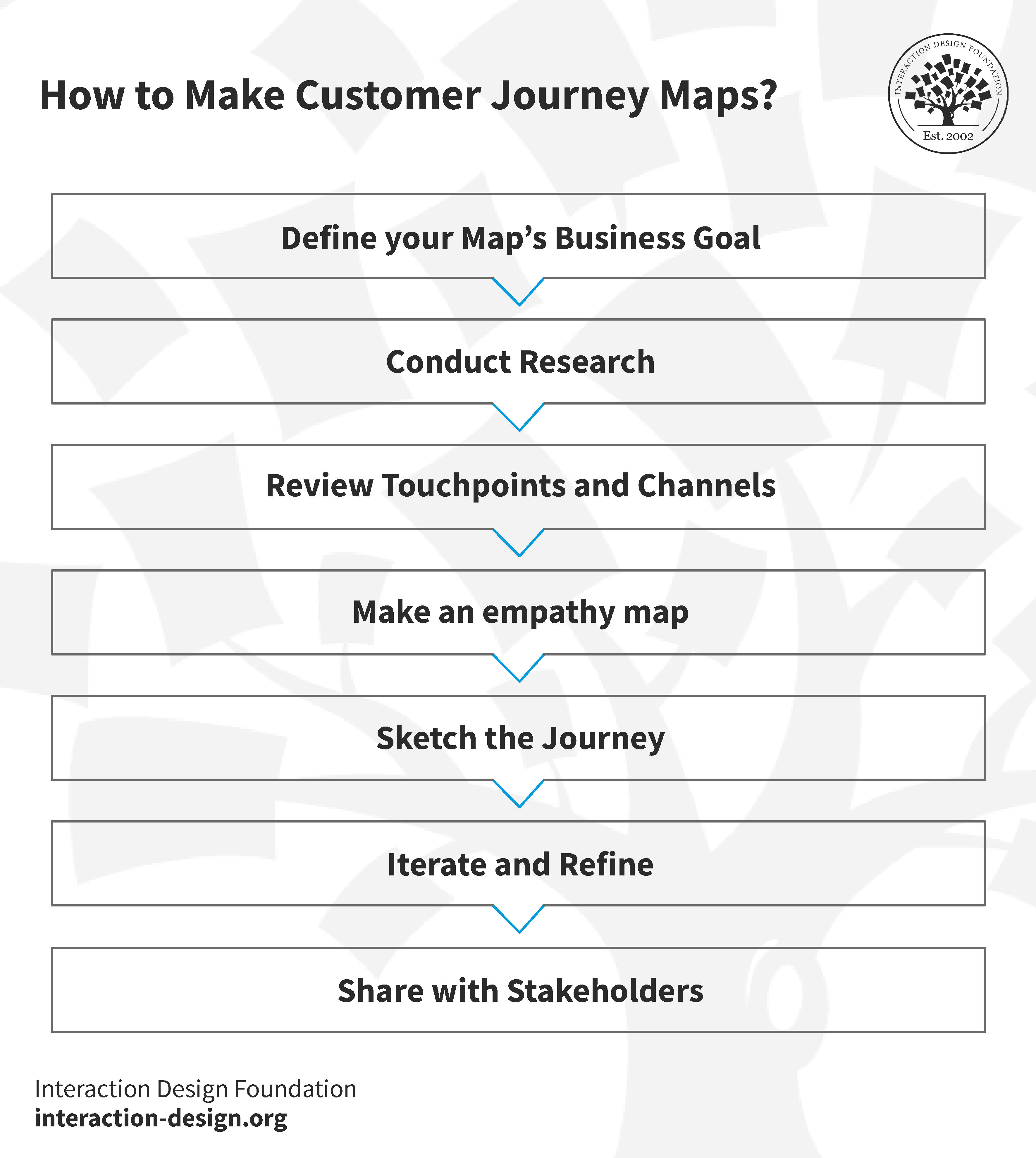
© Interaction Design Foundation, CC BY-SA 4.0
Define Your Map’s Business Goal
Before creating a customer journey map, you must ask yourself why you're making one in the first place. Clarify who will use it and what user experience it will address.
Conduct Research
Use customer research to determine customer experiences at all touchpoints. Get analytical/statistical data and anecdotal evidence. Leverage customer interviews, surveys, social media listening, and competitive intelligence.
Watch user researcher Ditte Hvas Mortensen talk about how user research fits your design process and when you should do different studies.
- Copyright holder: Unsplash. Copyright terms and license: CCO Public Domain. Link: https://pixabay.com/en/clay-hands-sculpting-art-69...
- Copyright holder: Unsplash. Copyright terms and license: CCO Public Domain. Link: https://www.pexels.com/photo/man-in-black-shirt-an...
- Copyright holder: Indecent Proposer. Copyright terms and license: CC BY-NC 2.0 Link: https://www.flickr.com/photos/indecent_proposal/14...
- Copyright holder: Anna Langova. Copyright terms and license: CC0 1.0 Link: http://www.publicdomainpictures.net/view-image.php...
- Copyright holder: Conmongt. Copyright terms and license: CC0 Public Domain Link: https://pixabay.com/en/hourglass-time-time-lapse-clock-1623517/
Review Touchpoints and Channels
List customer touchpoints (e.g., paying a bill) and channels (e.g., online). Look for more touchpoints or channels to include.
Make an Empathy Map
Pinpoint what the customer does, thinks, feels, says, hears, etc., in a given situation. Then, determine their needs and how they feel throughout the experience. Focus on barriers and sources of annoyance.
Sketch the Journey
Piece everything—touchpoints, timescale, empathy map output, new ideas, etc.). Show a customer’s course of motion through touchpoints and channels across the timescale, including their feelings at every touchpoint.
Iterate and Refine
Revise and transform your sketch into the best-looking version of the ideal customer journey.
Share with Stakeholders
Ensure all stakeholders understand your map and appreciate how its use will benefit customers and the organization.
Buyer Journey vs User Journey vs Customer Journey: What's the Difference?
You must know the differences between buyer, user, and customer journeys to optimize customer experiences. A customer journey map is often synonymous with a user flow diagram or buyer journey map. However, each journey gives unique insights and needs different plans.
Customer Journey
The customer journey, or lifecycle, outlines the stages a customer goes through with a business. This journey can vary across organizations but includes five key steps:
1. Awareness : This is the first stage of the customer journey, where the customers realize they have a problem. The customer becomes aware of your brand or product at this stage, usually due to marketing efforts.
2. Consideration : Once customers know about your product or service, they start their research and compare brands.
3. Purchase : This is the stage where the customer has chosen a solution and is ready to buy your product or service.
4. Retention : After the purchase, it's about retaining that customer and nurturing a relationship. This is where good customer service comes in.
5. Advocacy : Also called the loyalty stage, this is when the customer not only continues to buy your product but also recommends it to others.
The journey doesn't end when the customer buys and recommends your solution to others. Customer journey strategies are cyclical and repetitive. After the advocacy stage, ideally, you continue to attract and retain the customers, keeping them in the cycle.
There is no standard format for a customer journey map. The key is to create one that works best for your team and product or service. Get started with customer journey mapping with our template:
This customer journey map template features three zones:
Top – persona and scenario.
Middle – thoughts, actions, and feelings.
Bottom – insights and progress barriers.
Buyer Journey
The buyer's journey involves the buyer's path towards purchasing. This includes some of the steps we saw in the customer journey but is specific to purchasing :
1. Awareness Stage : This is when a prospective buyer realizes they have a problem. However, they aren't yet fully aware of the solutions available to them.
2. Consideration Stage : After identifying their problem, the buyer researches and investigates different solutions with more intent. They compare different products, services, brands, or strategies here.
3. Decision Stage : The buyer then decides which solution will solve their problem at the right price. This is where the actual purchasing action takes place.
4. Post-Purchase Evaluation : Although not always included, this stage is critical. It's where the buyer assesses their satisfaction with the purchase. It includes customer service interactions, quality assessment, and attitudinal loyalty to the brand.
All these stages can involve many touchpoints, including online research, social media interactions, and even direct, in-person interactions. Different buyers may move through these stages at different speeds and through various channels, depending on a wide range of factors.
User Journey
The user journey focuses on people's experience with digital platforms like websites or software. Key stages include:
1. Discovery : In this stage, users become aware of your product, site, or service, often due to marketing efforts, word-of-mouth, or organic search. It also includes their initial reactions or first impressions.
2. Research/Consideration : Here, users dig deeper, exploring features, comparing with alternatives, and evaluating if your offering suits their needs and preferences.
3. Interaction/Use : Users actively engage with your product or service. They first-hand experience your solution's functionality, usability, and usefulness to achieve their goal.
4. Problem-solving : If they encounter any issues, how they seek help and resolve their issues fall into this stage. It covers user support, troubleshooting, and other assistance.
5. Retention/Loyalty : This stage involves how users stay engaged over time. Do they continue using your product, reduce usage, or stop altogether? It includes their repeated interactions, purchases, and long-term engagement over time.
6. Advocacy/Referral : This is when users are so satisfied they begin to advocate for your product, leaving positive reviews and referring others to your service.
Download this user journey map template featuring an example of a user’s routine.

Understanding these stages can help optimize the user experience, providing value at each stage and making the journey seamless and enjoyable.
Always remember the journey is as important as the destination. Customer relationships start from the first website visit or interaction with marketing materials. These initial touchpoints can influence the ongoing relationship with your customers.
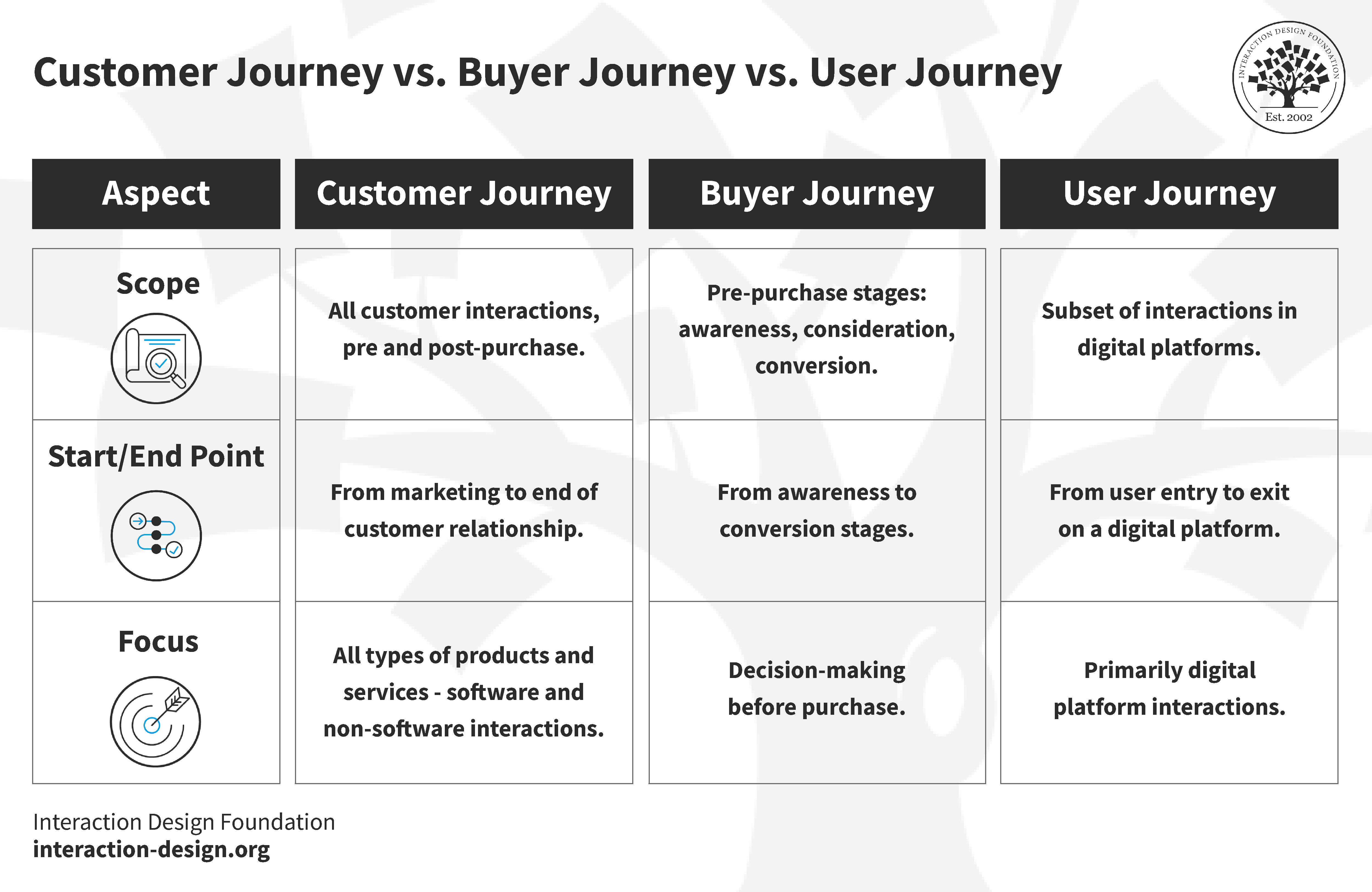
© Interaction Design Foundation, CC BY-SA 3.0
Drawbacks of Customer Journey Maps
Customer journey mapping is valuable yet has limitations and potential drawbacks. Recognize these challenges and create more practical and realistic journey maps.
Over-simplification of Customer Experiences
Customer journey maps often risk simplifying complex customer experiences . They may depict varied and unpredictable customer behaviors as straightforward and linear. This simplification can lead to misunderstandings about your customers' needs and wants. As a result, you might overlook customers' diverse and unique paths.
Always remember that real customer experiences are more complex than any map. When you recognize this, you steer clear of decisions based on simple models.
Resource Intensity
Creating detailed customer journey maps requires a lot of resources and time. You must gather extensive data and update the maps to keep them relevant. This process can strain small businesses or those with limited resources.
You need to balance the need for comprehensive mapping with available resources. Efficient resource management and prioritization are crucial to maintaining effective journey maps.
Risk of Bias
Creating customer journey maps carries the inherent risk of biases . These biases can arise from various sources. They can impact the accuracy and effectiveness of the maps.
Alan Dix, an expert in HCI, discusses bias in more detail in this video.
Common biases in customer journey mapping include:
Assumption Bias: When teams make decisions based on preconceived notions rather than customer data.
Selection Bias: When the data doesn’t represent the entire customer base..
Confirmation Bias : When you focus on information that supports existing beliefs and preferences. Simultaneously, you tend to ignore or dismiss data that contradicts those beliefs.
Anchoring Bias : Relying on the first information encountered (anchor) when making decisions.
Overconfidence Bias : Placing too much trust in the accuracy of the journey map. You may overlook its potential flaws.
These biases may misguide the team, and design decisions based on these maps might not be effective.
To address these biases, review and update journey maps with real user research data. Engage with different customer segments and gather a wide range of feedback to help create a more accurate and representative map. This approach ensures the journey map aligns with actual customer experiences and behaviors.
Evolving Customer Behaviors
Customer behaviors and preferences change with time. A journey map relevant today can become outdated. You need to update and adapt your maps to reflect these changes. This requires you to perform market research and stay updated with trends and customer feedback.
Getting fresh data ensures your journey map stays relevant and effective. You must adapt to evolving customer behaviors to maintain accurate and valuable customer journey maps.
Challenges in Capturing Emotions
Capturing emotions accurately in customer journey maps poses a significant challenge. Emotions influence customer decisions, yet you may find it difficult to quantify and represent them in maps. Most journey maps emphasize actions and touchpoints, often neglecting the emotional journey.
You must integrate emotional insights into these maps to understand customer experiences. This integration enhances the effectiveness of customer engagement strategies. You can include user quotes, symbols such as emojis, or even graphs to capture the ups and downs of the users’ emotions..
Misalignment with Customer Needs
Misalignments in customer journey maps can manifest in various ways. It can impact the effectiveness of your strategies. Common misalignments include:
Putting business aims first, not what customers need.
Not seeing or serving the varied needs of different customer types.
Not using customer feedback in the journey map.
Thinking every customer follows a simple, straight path.
Engage with your customers to understand their needs and preferences if you want to address these misalignments. Incorporate their direct feedback into the journey map. This approach leads to more effective customer engagement and satisfaction.
Over-Reliance on the Map
Relying too much on customer journey maps can lead to problems. These maps should serve as tools rather than definitive guides. Viewing them as perfect can restrict your responsiveness to customer feedback and market changes. Treat journey maps as evolving documents that complement direct customer interactions and feedback.
Make sure you get regular updates and maintain flexibility in your approach. Balance the insights from the map with ongoing customer engagement. This approach keeps your business agile and responsive to evolving customer needs.
Data Privacy Concerns
Collecting customer data for journey mapping poses significant privacy concerns. Thus, you need to create a balance. You must adhere to data protection laws and gather enough information for mapping.
You need a careful strategy to ensure customer data security. Stay vigilant to adapt to evolving privacy regulations and customer expectations. This vigilance helps maintain trust and compliance.
Learn More about Customer Journey Maps
Take our Journey Mapping course to gain insights into the how and why of journey mapping. Learn practical methods to create experience maps , customer journey maps, and service blueprints for immediate application.
Explore this eBook to discover customer journey mapping .
Find some additional insights in the Customer Journey Maps article.
Questions related to Customer Journey Maps
Creating a customer journey map requires visually representing the customer's experience with your product or company. Harness the strength of visual reasoning to understand and present this journey succinctly. Instead of detailing a lengthy narrative, like a book, a well-crafted map allows stakeholders, whether designers or not, to grasp the journey quickly. It's a democratized tool that disseminates information, unifies teams, and aids decision-making by illuminating previously unnoticed or misunderstood aspects of the customer's journey.
The customer journey encompasses five distinct stages that guide a customer's interaction with a brand or product:
Awareness: The customer becomes aware of a need or problem.
Consideration: They research potential solutions or products.
Purchase: The customer decides on a solution and makes a purchase.
Retention: Post-purchase, the customer uses the product and forms an opinion.
Advocacy: Satisfied customers become brand advocates, sharing their positive experiences.
For a comprehensive understanding of these stages and how they intertwine with customer touchpoints, refer to Interaction-Design.org's in-depth article .
A perspective grid workshop is a activity that brings together stakeholders from various departments, such as product design, marketing, growth, and customer support, to align on a shared understanding of the customer's journey. These stakeholders contribute unique insights about customer needs and how they interact with a product or service. The workshop entails:
Creating a matrix to identify customers' jobs and requirements, not initially linked to specific features.
Identifying the gaps, barriers, pains, and risks associated with unmet needs, and constructing a narrative for the journey.
Highlighting the resulting value when these needs are met.
Discuss the implied technical and non-technical capabilities required to deliver this value.
Brainstorming possible solutions and eventually narrowing down to specific features.
The ultimate aim is to foster alignment within the organization and produce a user journey map based on shared knowledge.
Learn more from this insightful video:
Customer journey mapping is vital as it harnesses our visual reasoning capabilities to articulate a customer's broad, intricate journey with a brand. Such a depiction would otherwise require extensive documentation, like a book. This tool offers a cost-effective method to convey information succinctly, ensuring understanding of whether one is a designer or lacks the time for extensive reading. It also helps the team to develop a shared vision and to encourage collaboration. Businesses can better comprehend and address interaction points by using a journey map, facilitating informed decision-making and revealing insights that might otherwise remain obscured. Learn more about the power of visualizing the customer journey in this video.
Pain points in a customer journey map represent customers' challenges or frustrations while interacting with a product or service. They can arise from unmet needs, gaps in service, or barriers faced during the user experience. Identifying these pain points is crucial as they highlight areas for improvement, allowing businesses to enhance the customer experience and meet their needs more effectively. Pain points can relate to various aspects, including product usability, communication gaps, or post-purchase concerns. Explore the detailed article on customer journey maps at Interaction Design Foundation for a deeper understanding and real-world examples.
Customer journey mapping offers several key benefits:
It provides a holistic view of the customer experience, highlighting areas for improvement. This ensures that products or services meet users' needs effectively.
The process fosters team alignment, ensuring everyone understands and prioritizes the customer's perspective.
It helps identify pain points, revealing opportunities to enhance user satisfaction and loyalty.
This visualization allows businesses to make informed decisions, ensuring resources target the most impactful areas.
To delve deeper into the advantages and insights on journey mapping, refer to Interaction Design Foundation's article on key takeaways from the IXDF journey mapping course .
In design thinking, a customer journey map visually represents a user's interactions with a product or service over time. It provides a detailed look at a user's experience, from initial contact to long-term engagement. Focusing on the user's perspective highlights their needs, emotions, pain points, and moments of delight. This tool aids in understanding and empathizing with users, a core principle of design thinking. When used effectively, it bridges gaps between design thinking and marketing, ensuring user-centric solutions align with business goals. For a comprehensive understanding of how it fits within design thinking and its relation to marketing, refer to Interaction Design Foundation's article on resolving conflicts between design thinking and marketing .
A customer journey map and a user journey map are tools to understand the experience of users or customers with a product or service.
A customer journey map is a broader view of the entire customer experience across multiple touchpoints and stages. It considers physical and digital channels, multiple user personas, and emotional and qualitative aspects.
A user journey map is a detailed view of the steps to complete a specific task or goal within a product or service. It only considers digital channels, one user persona, and functional and quantitative aspects.
Both are useful to understand and improve the experience of the users or customers with a product or service. However, they have different scopes, perspectives, and purposes. A customer journey map provides a holistic view of the entire customer experience across multiple channels and stages. A user journey map provides a detailed view of the steps to complete a specific task or goal within a product or service.
While user journeys might emphasize specific tasks or pain points, customer journeys encapsulate the entire experience, from research and comparison to purchasing and retention.
Customer journey maps and service blueprints are tools to understand and improve the experience of the users or customers with a product or service. A customer journey map shows the entire customer experience across multiple touchpoints and stages. It focuses on the front stage of the service, which is what the customers see and experience. It considers different user personas and emotional aspects.
A service blueprint shows how a service is delivered and operated by an organization. It focuses on the back stage of the service, which is what the customers do not see or experience. It considers one user persona and functional aspects. What are the steps that the customer takes to complete a specific task or goal within the service? What are the channels and devices that the customer interacts with at each step?
For an immersive dive into customer journey mapping, consider enrolling in the Interaction Design Foundation's specialized course . This course offers hands-on lessons, expert guidance, and actionable tools. Furthermore, to grasp the course's essence, the article “4 Takeaways from the IXDF Journey Mapping Course” sheds light on the core learnings, offering a snapshot of what to expect. These resources are tailored by industry leaders, ensuring you're equipped with the best knowledge to craft impactful customer journey maps.
Literature on Customer Journey Maps
Here’s the entire UX literature on Customer Journey Maps by the Interaction Design Foundation, collated in one place:
Learn more about Customer Journey Maps
Take a deep dive into Customer Journey Maps with our course Journey Mapping .
This course will show you how to use journey mapping to turn your own complex design challenges into simple, delightful user experiences . If you want to design a great shopping experience, an efficient signup flow or an app that brings users delight over time, journey mapping is a critical addition to your toolbox.
We will begin with a short introduction to mapping — why it is so powerful, and why it is so useful in UX. Then we will get familiar with the three most common types of journey map — experience maps, customer journey maps and service blueprints — and how to recognize, read and use each one. Then you will learn how to collect and analyze data as a part of a journey mapping process. Next you will learn how to create each type of journey map , and in the final lesson you will learn how to run a journey mapping workshop that will help to turn your journey mapping insights into actual products and services.
This course will provide you with practical methods that you can start using immediately in your own design projects, as well as downloadable templates that can give you a head start in your own journey mapping projects.
The “Build Your Portfolio: Journey Mapping Project” includes three practical exercises where you can practice the methods you learn, solidify your knowledge and if you choose, create a journey mapping case study that you can add to your portfolio to demonstrate your journey mapping skills to future employers, freelance customers and your peers.
Throughout the course you will learn from four industry experts.
Indi Young will provide wisdom on how to gather the right data as part of your journey mapping process. She has written two books, Practical Empathy and Mental Models . Currently she conducts live online advanced courses about the importance of pushing the boundaries of your perspective. She was a founder of Adaptive Path, the pioneering UX agency that was an early innovator in journey mapping.
Kai Wang will walk us through his very practical process for creating a service blueprint, and share how he makes journey mapping a critical part of an organization’s success. Kai is a talented UX pro who has designed complex experiences for companies such as CarMax and CapitalOne.
Matt Snyder will help us think about journey mapping as a powerful and cost-effective tool for building successful products. He will also teach you how to use a tool called a perspective grid that can help a data-rich journey mapping process go more smoothly. In 2020 Matt left his role as the Sr. Director of Product Design at Lucid Software to become Head of Product & Design at Hivewire.
Christian Briggs will be your tour guide for this course. He is a Senior Product Designer and Design Educator at the Interaction Design Foundation. He has been designing digital products for many years, and has been using methods like journey mapping for most of those years.
All open-source articles on Customer Journey Maps
14 ux deliverables: what will i be making as a ux designer.

- 1.2k shares
What are Customer Touchpoints & Why Do They Matter?

- 3 years ago
How to Visualize Your Qualitative User Research Results for Maximum Impact

- 2 years ago
How to Resolve Conflicts Between Design Thinking and Marketing

How to Create a Perspective Grid

- 11 mths ago
4 Takeaways from the IxDF Journey Mapping Course
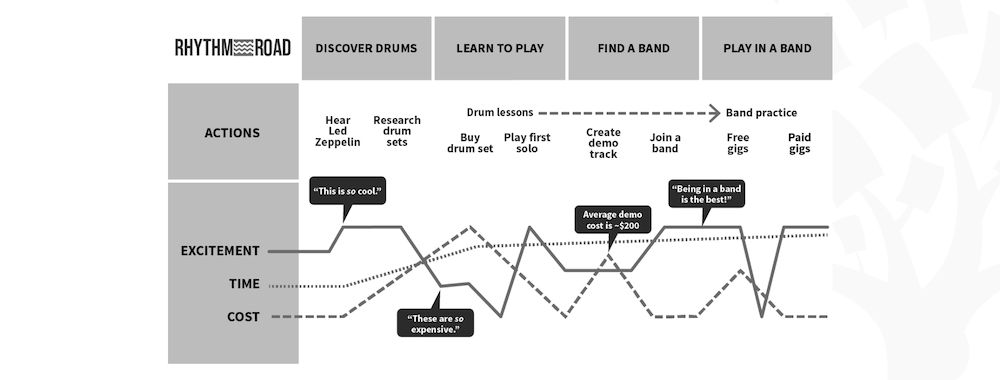
The Power of Mapping
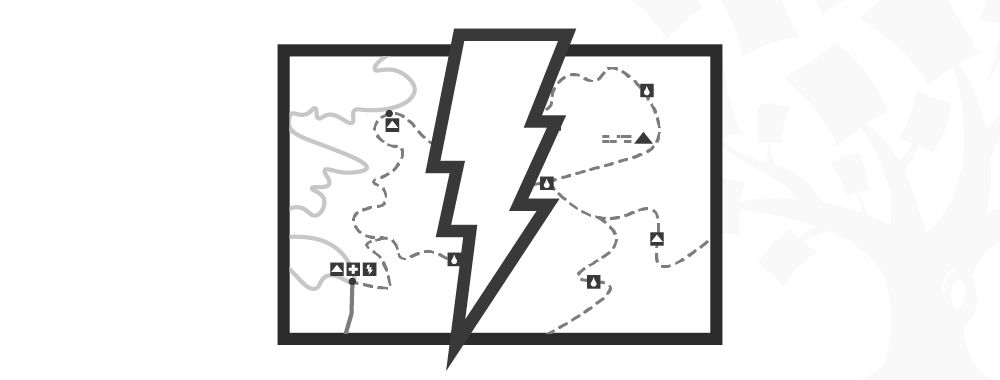
User Story Mapping in Design
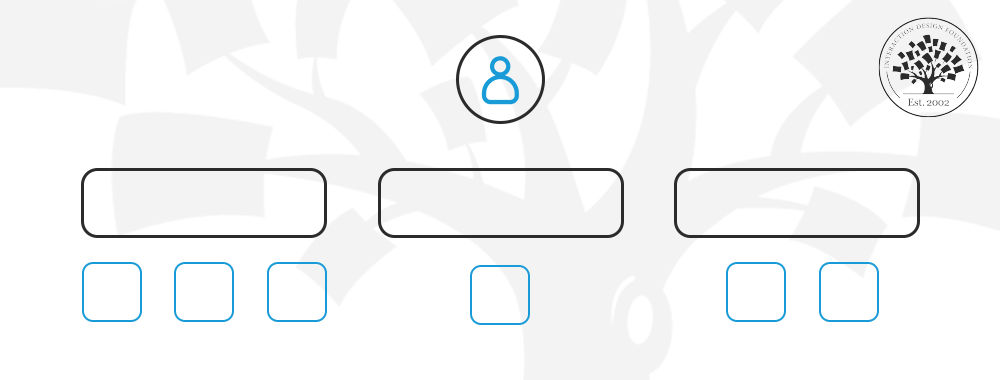
Open Access—Link to us!
We believe in Open Access and the democratization of knowledge . Unfortunately, world-class educational materials such as this page are normally hidden behind paywalls or in expensive textbooks.
If you want this to change , cite this page , link to us, or join us to help us democratize design knowledge !
Privacy Settings
Our digital services use necessary tracking technologies, including third-party cookies, for security, functionality, and to uphold user rights. Optional cookies offer enhanced features, and analytics.
Experience the full potential of our site that remembers your preferences and supports secure sign-in.
Governs the storage of data necessary for maintaining website security, user authentication, and fraud prevention mechanisms.
Enhanced Functionality
Saves your settings and preferences, like your location, for a more personalized experience.
Referral Program
We use cookies to enable our referral program, giving you and your friends discounts.
Error Reporting
We share user ID with Bugsnag and NewRelic to help us track errors and fix issues.
Optimize your experience by allowing us to monitor site usage. You’ll enjoy a smoother, more personalized journey without compromising your privacy.
Analytics Storage
Collects anonymous data on how you navigate and interact, helping us make informed improvements.
Differentiates real visitors from automated bots, ensuring accurate usage data and improving your website experience.
Lets us tailor your digital ads to match your interests, making them more relevant and useful to you.
Advertising Storage
Stores information for better-targeted advertising, enhancing your online ad experience.
Personalization Storage
Permits storing data to personalize content and ads across Google services based on user behavior, enhancing overall user experience.
Advertising Personalization
Allows for content and ad personalization across Google services based on user behavior. This consent enhances user experiences.
Enables personalizing ads based on user data and interactions, allowing for more relevant advertising experiences across Google services.
Receive more relevant advertisements by sharing your interests and behavior with our trusted advertising partners.
Enables better ad targeting and measurement on Meta platforms, making ads you see more relevant.
Allows for improved ad effectiveness and measurement through Meta’s Conversions API, ensuring privacy-compliant data sharing.
LinkedIn Insights
Tracks conversions, retargeting, and web analytics for LinkedIn ad campaigns, enhancing ad relevance and performance.
LinkedIn CAPI
Enhances LinkedIn advertising through server-side event tracking, offering more accurate measurement and personalization.
Google Ads Tag
Tracks ad performance and user engagement, helping deliver ads that are most useful to you.
Share the knowledge!
Share this content on:
or copy link
Cite according to academic standards
Simply copy and paste the text below into your bibliographic reference list, onto your blog, or anywhere else. You can also just hyperlink to this page.
New to UX Design? We’re Giving You a Free ebook!

Download our free ebook The Basics of User Experience Design to learn about core concepts of UX design.
In 9 chapters, we’ll cover: conducting user interviews, design thinking, interaction design, mobile UX design, usability, UX research, and many more!
- cx management
organise full control over your customer experience
- service innovation
design services your customers actually want
train your teams to become CX experts themselves
- about Essense
we make customer experience operational
a team of service designers, ux designers and cx consultants

Questions? Just call us
020-7371881
how to create a customer journey map ( + template )

Arne Hutter
Client Consultant

Every company wants to give their customers the best possible experience. The first step in creating it, is to clearly map out what the customer experience actually looks like. A customer journey map is a commonly used tool to visually map this experience. Unfortunately, the words ‘ journey map ‘ and ‘ customer journey ‘ have become such buzzwords, that they seem to have lost their true value. That is why we feel the need to go back to the basics, and explain what a journey map actually is, why should you create one, and how could you use it in practice?
why to create a journey map?
Journey mapping is nothing more than mapping a customer experience, and a popular tool within the practice of service design. A journey map (or customer journey) is the outcome of this process: a visualization (map) of the customer experience. As the term suggests, it shows the journey a customer goes through when using your services. Making a journey map is therefore never a goal in itself, but a means to better empathize with your customer, and to gain clarity on where to improve the experience.
different types of journeys
What a journey map looks like, depends on what you will use it for. Before we dive into the different parts of a journey map, it is important to understand what type of journeys you could use and when to apply them. Broadly speaking, we distinguish two properties: (1) The level of detail (macro vs. micro) and (2) The situation (as-is vs. to-be). If you plot these on two axes, this creates four types of journeys, each serving its own purpose.
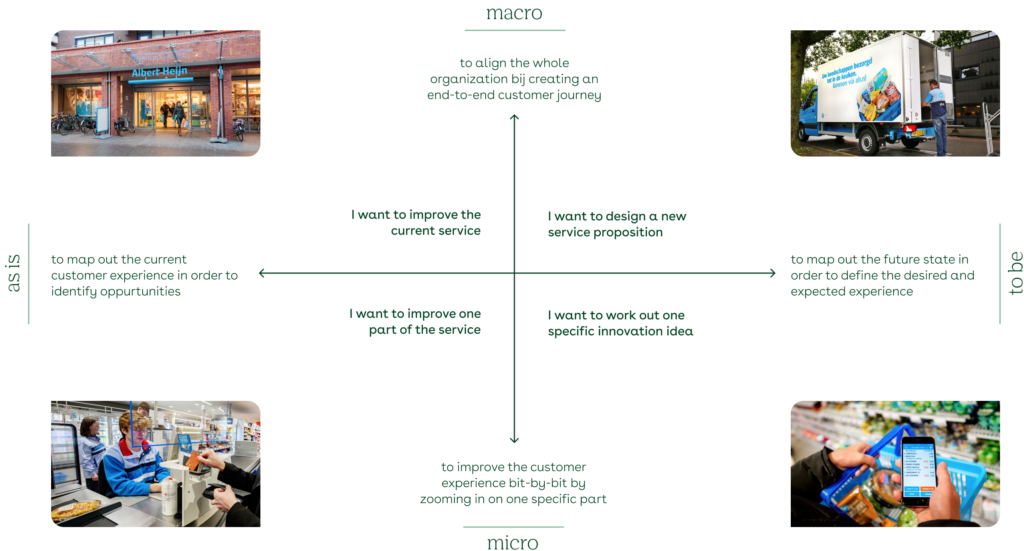
macro vs micro A journey map can visualize the customer experience of your entire service (macro) or zoom in on a smaller part of the service (micro). Is your goal to create an overview of the entire (end-to-end) customer experience, and to align your internal team to work on a shared ambition? Then you create a Macro journey. On the other hand, do you already know which part of your service you want to focus on, and is your goal to implement targeted improvements? Then you create a Micro journey.
as-is vs to-be A journey map can visualize the current customer experience (as-is), or sketch a desired future situation (to-be). Is your goal to define opportunities for improvement based on the current customer experience? Then you should create an as-is journey map. Do you want to show what an improved customer experience should look like, or develop a new service? Then you should create a to-be journey map.
what does a journey map look like?
Journey maps come in many forms. That’s a good thing because a journey map is always tailor-made. Which parts you add to your journey map depends (just like the type) on the goal, but broadly speaking, a journey map contains four basic parts. To clarify this, we will use the customer experience of a fictional customer journey.
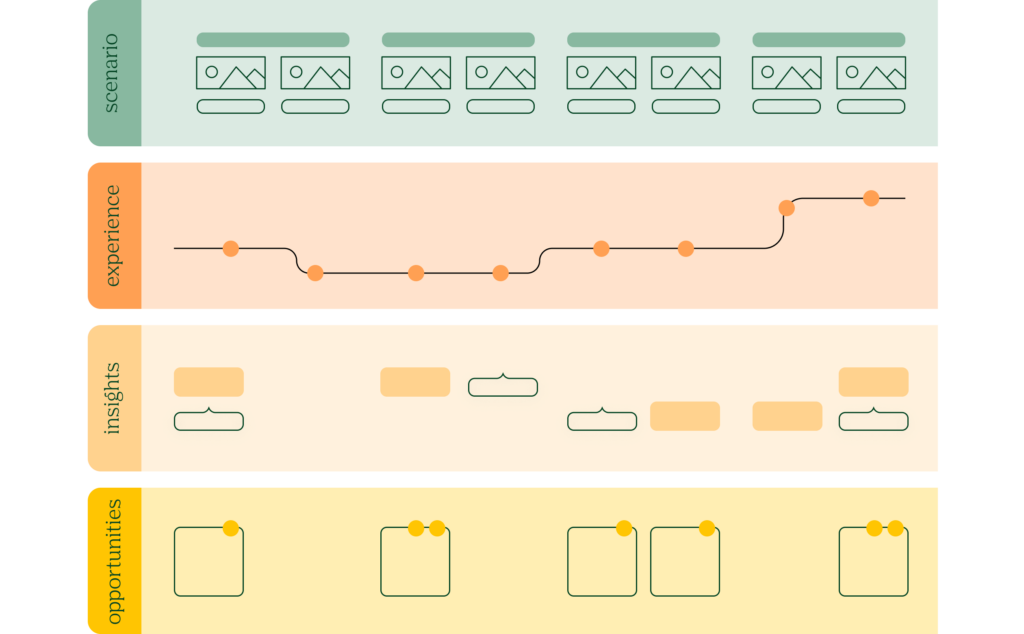
1. Scenario The scenario describes the phases and steps a customer goes through when using your services. Phases broadly describe the moments (stages) that a customer goes through during his journey and often consist of several steps. Steps are the individual scenes of the storyline that involve one or more actions. The steps serve as a stepping stone for the rest of the journey map and therefore also determine how detailed your journey will be.
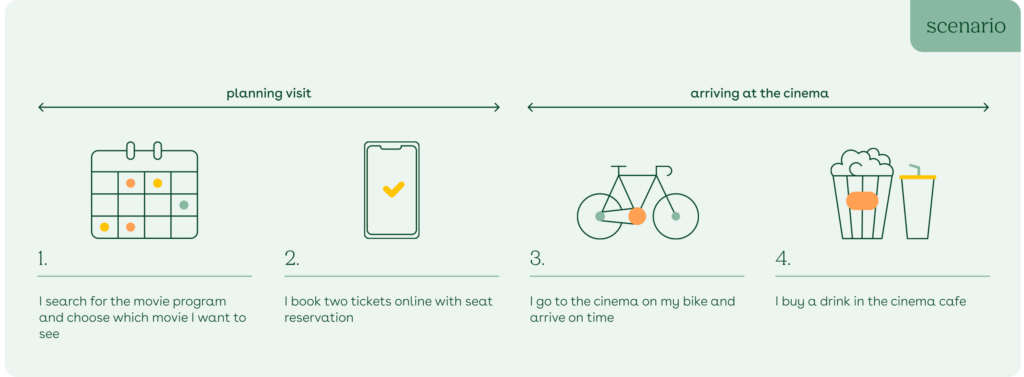
2. Experience (emotion curve) Below the scenario, you’ll find the experience of the customer, visualized in an emotion curve. The emotion curve (also known as mood curve) roughly shows the emotion the customer feels during the journey. You can choose to summarize the emotion for all customers, or to create multiple curves based on your need based profiles. You mainly use the mood curve as a guideline for your story and as a summary of your research; when does the customer have positive experiences and when negative ones? Keep in mind that this line is not created by taking the sum of all experiences. That would result in a very flat curve, while we want to highlight peaks and troughs.
We always support the curve with a (fictitious) quote that is representative of the customer experience at that moment. In the example you can see that the customer experience explains why the emotion curve is a trough or a peak. In this chapter we also mark the key moments; these are the steps in which the relevant experience most determines the total experience of the entire journey.

3. Insights Under the experience are supporting insights from your research. These are findings that emerge from customer data and allow the reader to understand the customer’s needs and pain points. An insight is often supported by quotes from customer research. This allows the reader to empathise with the user even better. You can label insights to quickly distinguish them; for example, whether they are negative, positive, or neutral. Sometimes insights are specifically about one customer profile. It is therefore useful to give these a label.
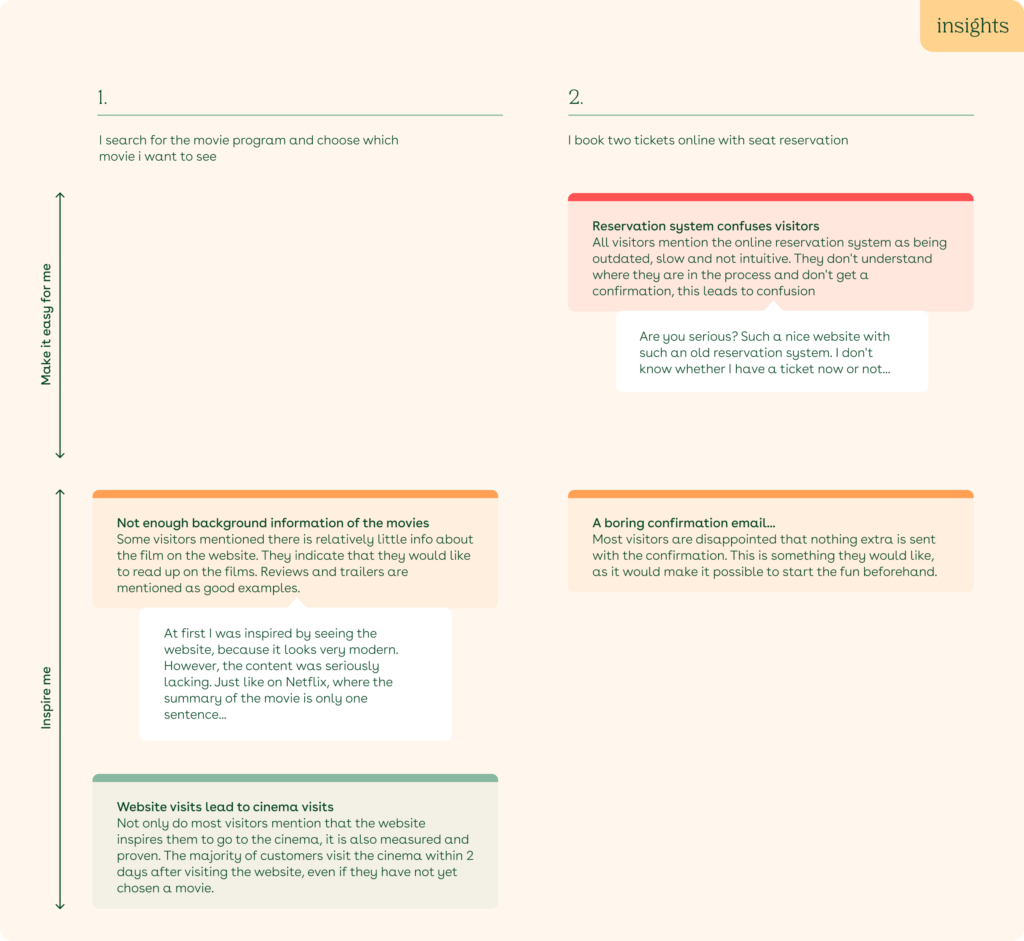
4. Opportunities Last but not least, there are the opportunities on the journey map. After all, we want to uncover where we can improve! By looking closely at the insights and experience of the customer during the journey, you can spot opportunities to improve your service. Note: An opportunity provides direction for the generation of solutions, and is not the solution in itself. It may help to use a standardized sentence. An example of this is the user-story format: As [customer profile] I want [to meet needs] , so that I [experience this benefit] .
This way it is clear what the customer needs, but you leave enough room for multiple solutions.
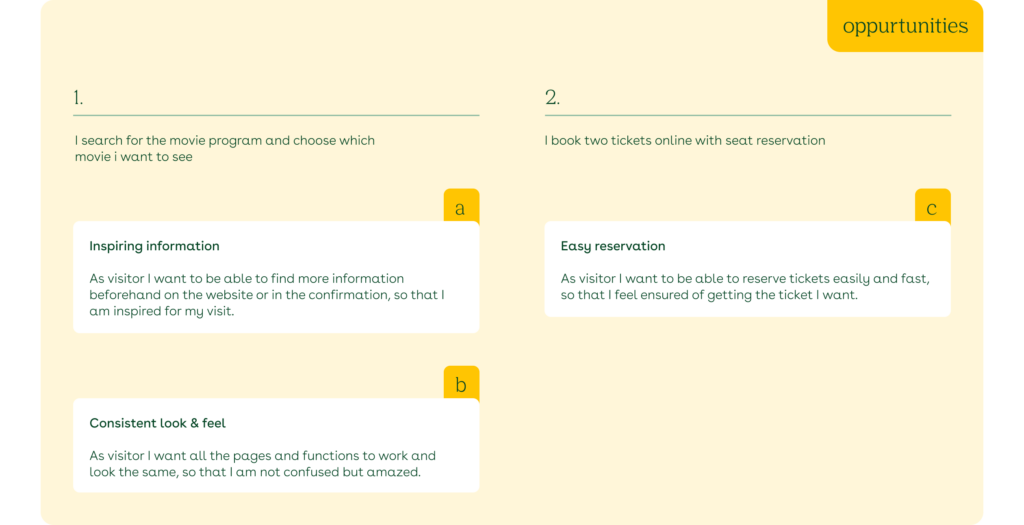
In addition to these four basic parts, you can add many other parts to a journey map. Examples of this are: touchpoints and channels, descriptions of customer profiles and other components that provide insight into the customer journey.
now that I created a journey map, what’s next?
As said before, we think it’s a shame if the journeys are applied incorrectly or become a goal in itself. We’ve discussed the different types and when to use them. We also explained what a journey map looks like and how you can build this. Although journey maps come in many shapes and sizes, they have one thing in common: that they must be translated into concrete action points. On this, we’ve written a separate article, which can be found here .
getting started
Do you want to master journey mapping yourself? Then we recommend that you try it out as soon as possible. To help you on your way, we offer training courses that are tailored to your organisation. Would you rather hand it over completely? Then you can of course also contact us.
Whatever you choose, always keep the do’s and don’ts below in mind when you start with journey mapping.
Never create a journey map just for the sake of having one. Creating a journey map without a clear goal is a tedious process, and will probably not be used.
Never base your journey map on gut-feeling and internal insights. Think you know what your customer is experiencing? Think again.
A nicely formatted static journey map can certainly be valuable, but make sure it never ‘disappears in a drawer’. Turn your journey map into action and invest in ownership.
Don’t view journey mapping as something that concerns only your department. To put the customer in the heart of your organization, everyone has to be involved.
Always start by defining a clear goal. Only when you know why you want to create one, can you determine the best way of doing it.
Always base the journey map on real customer experiences. This is the only way to really innovate in a customer-centric way.
Make the journey map easily accessible for the entire organisation. A journey management tool like TheyDo can help you with this.
Include key stakeholders from the start of the process. They will not only provide you with valuable input, but are extremely important in creating support.
download our free template!
Want to create a journey map yourself? Then we recommend trying it out as soon as possible. To help you get started, we created a free template for you to use. This gives you a first impression of how it works and what it takes to complete it. Use the form below to download the template.
Share this article
Want to know how we can help your organisation become more customer-centric?
Please contact us at [email protected]

This next article may also be of interest to you.
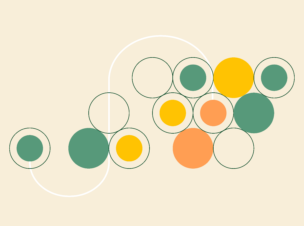
how a design system can improve your customer experience
Also interesting.

aligning teams for a seamless customer experience

cx strategy

Coöperatie VGZ implementation & training in TheyDo
Like to read more.
Enter your e-mail address and receive our articles in your mailbox from now on.
" * " indicates required fields
Privacy Overview
- How to Use This Site
- Usability Testing
- Domain Modeling
Taxonomy Design
- Wireframing
- Accessibility Evaluation
- Journey Mapping
- See All Methods A-Z
- Content Strategy
- Information Architecture
- Interaction Design
- Usability Evaluation
- User Research
- Visual Design

Photo by UX Indonesia via Unsplash
Journey Mapping Method
A journey map is a holistic, visual representation of a user’s experience with a product or service over time. Journey maps combine data and insight from other research and discovery methods to provide a detailed description from the user’s point of view of steps taken, decisions made, successes, pain points, and emotions felt.
Journey maps help designers understand the user’s motivations and needs at each step of a process, from the earliest earliest phases of researching a product or service all the way through adoption, providing crucial insight for designing solutions that better meet user and business needs. The journey map’s visual and storytelling elements also help it communicate research data and findings to broader audiences within an organization.
Preparation
Journey Mapping is often more effective when it is informed by these complementary methods.

Contextual Interviewing
Observation of users performing tasks in their own environment

Task Analysis
Observe users in action to understand how they perform tasks to achieve goals

Written descriptions of how users will perform tasks with your product or on your website

A specific user's context, motivations, and goals for visiting a website or app

Stakeholder Interviewing
Understanding the perspective and influence of those invested in a project's success

User Interviewing
Understand the tasks and motivations of the user group for whom you are designing
- Define business and user goals Clearly articulate the organizational goals for the product or service, the design and business goals for the mapping exercise, and the goals of the target user the map is to represent.
- Gather research data Effective journey maps are based on qualitative and quantitative data collected across a range of activities. Review and incorporate existing research as you create your journey map, and note where gaps in understanding indicate the need for additional research.
- Identify touchpoints and channels Touchpoints describe what users do and how they do it. Channels describe where the interaction takes place (e.g. website, call center, native app, or in-store).
- Create an Empathy Map Empathy maps describe what users do, think, feel, say, and hear in a given situation. They help you understand and articulate users’ emotional state, and provide the basis for illustrating the peaks and valleys of frustration, anxiety, happiness, etc.
- Sketch the journey Visualize the order in which users exhibit behaviors, use information, make decisions, and feel emotions. Group elements into phases related to the narrative of each user. Integrate touchpoints, channels, empathy insights, and other research to show the user’s course of motion across the timescale as a whole. Include the user’s feelings at each touchpoint.
- Review, refine, and revise Review your draft journey with team members and subject matter experts to gain new insight and integrate new perspectives. Use these to identify additional opportunities to make your journey map more accurate, more expressive of the data, and more useful for the design process. From time to time, evaluate your map to make sure it remains accurate. Revise as necessary to account for evolving research, product development, and user and business needs.
Journey Mapping typically produces insight and solutions focused on these areas:
User Preference
Elements, arrangements, or qualities of experience design that user state or show are valuable to them.
User Behavior
Information about how users currently use a site, service, or resource.
Journey Mapping Resources

10 most interesting examples of Customer Journey Maps

7 Interesting Real Life Customer Journey Map Examples

Customer journey maps for content: Untangle complex insights and create better experiences

144 Best Customer Journey Map Templates and Examples

Category Design
Creating structures and schemes that make the location and use of content clear

Persona Creation
Development of research-informed representations of target user goals, behaviors, and pain points

Style Tile Creation
Communicate the use of fonts, colors, and interface elements in a design system

Define a system for labeling and classifying content to make it easier to find, understand, and use
Journey Mapping Method details last edited on Sunday, February 6, 2022
10 Steps to Mapping the Customer Journey
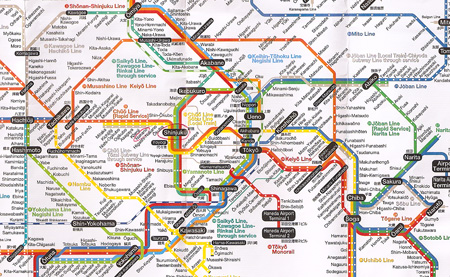
What were all the things that went well and what seemed like torture?
What impact did that experience have on your likelihood to make a future purchase or recommend the product or company to a friend?
Understanding the process people go through when engaging with a service or product provides a wealth of information to sales, marketing and product development teams.
A customer journey map is a natural extension of the sales and marketing funnel but has an impact beyond the marketing or sales teams. It’s a document meant to unify fragmented efforts and, most importantly, identify points of friction and opportunities for improvement. Finding and fixing the pain points in a customer’s journey isn’t just about damage control, it’s about the innovation that comes from fixing the pain.
While you can map just about any sequence of events, a journey map is ideal for any process that has a lot of steps or opportunities for friction, failure and improvement. For example, you can map the journeys of:
- Buying a new car
- A stay at a hotel
- Giving birth [pdf]
- A shop-floor supervisor
- A trip to Whole Foods
- Researching and purchasing a laptop
Here are 10 steps to take to building a journey map :
- Find the data : The journey map should be based on what actually happens and not on what you or the organization wants to happen. This doesn’t mean you shouldn’t use your experience to start sketching the journey. It means that you should validate and acknowledge your assumptions where you can so others can confirm or correct them. Look for existing data already collected or 3rd party reports on demographics, competition and benchmarks before starting a lengthy research endeavor.
- Pick a persona : There will likely be different journey maps for each persona or customer segment. However, many maps will likely have overlapping stages. It’s usually easiest to pick one persona, map that journey and then look for duplications and consolidate the maps later.
- Sales People
- Advertisements
- Customer Support Calls
Touchpoints are often the focal point for where an experience can go from pleasant to painful.
- Find the pain points : With the touchpoints, stages and steps defined you should identify what isn’t working well. I refer to this as customer friction. For example, while I was working at Intuit we used a technique called a Follow-me-home. Volunteer customers let a product manager and UX researcher observe them at home or at work. During some of these follow-me-homes, the Intuit teams noticed merchants would check-out customers using their Point of Sale cash-register, then manually import the transactions each day into QuickBooks. Even though the customers didn’t explicitly say this was a point of friction, it was clearly not a pleasant or efficient experience.
- Define the metrics for each stage : It’s likely that there are metrics being collected already for most customer stages. Most industries also have third party research providers who offer valuable competitive information in reports and benchmark analysis. For each stage you’ll want at least one good metric that’s meaningful to the customer and business. Below are the stages for the consumer electronics customer purchasing a laptop along with some metrics to quantify the quality of the experience.
- Awareness : Brand recognition and market share (percent of time your brand and product come to mind without promoting relative to competition)
- Consideration : Feature and concept association (percent of positive or on-target brand associations)
- Preference : Brand and product preference (customer satisfaction ratings with brands and products)
- Action : Usability Scores, Cart Abandonment Rates
- Loyalty : Net Promoter Scores , Likelihood to Repurchase
- Improve and innovate : Use the pain points and metrics to help identify opportunities for improvement. After consolidating data from the Follow-me-homes, the Intuit design teams came up with QuickBooks POS which eliminated the painful step of importing data and led to a successful product. That’s how pain points are opportunity for innovation.
- Assign accountability : The parable of the tragedy of the commons tells us that if everybody owns a process, then no one really does and it gets neglected. Have teams and individuals accountable and responsible for defining the metrics, methods and actions for improving the experience.
- Periodically validate : New products are developed and features move from being delighters to being expected. An outdated journey map may be worse than no journey map at all. With the accountability teams in place, be sure there is a regular audit or mechanism whereby data and assumptions are updated regularly.
← Back to Articles
Oct 5, 2020
How To Create A Customer Journey Map
- Digital Strategy
It goes without saying that a cohesive customer journey is absolutely critical for success. These marketers understand how a customer or user journey map can streamline processes and provide customers with a consistent experience with a brand. Ideally, a customer journey map transforms the online customer journey into a visually accessible method for digital marketers to use to their advantage.
To streamline your customer experience and be consistently available to consumers throughout their online experience, read on to uncover how you can create a best-in-class customer journey map for your own brand.
What Is a Customer Journey Map?
A customer journey map is a “visual representation of every experience your customers have with you.” Throughout their experience with your brand, a customer will most likely engage or be reminded of your brand on multiple platforms, in varying ways. A customer journey map helps your brand deliver a streamlined narrative of a customer’s experience throughout the online sales funnel.
Although it may seem that the journey from first interaction through to a sale is quite simple, it is anything but. A customer is bombarded with countless advertisements, newsletters, and competitive content on a daily basis. This makes their journey with your brand complicated, and a well-rounded customer journey map is your solution to making that experience easier.
Customers can interact with your brand in countless ways in the modern digital landscape. Some examples include :
- Reading a branded blog post
- Accessing your website from search engine platform
- Following your brand on varying social media channels
By creating a clear visualization of every possible way a customer can interact and contact your brand, a customer journey map can help you keep customers engaged while you increase conversions and revenue.
Why Create a Customer Journey Map?
With so much of the journey taking place digitally, it’s vital that digital marketers understand exactly where customers are interacting with your brand while providing accessible, high-quality content on a regular basis.
With an effective customer journey map, digital marketers will gain a better understanding of how their customers interact with their business while accessing helpful insight into what channels are most effective for converting leads into prospects, and prospects into loyal customers.
Gone are the days when products were traditionally marketed by boasting specific features. Modern buyers are interested in the brand as a whole, how they personally engage with them, and most importantly, how the offering can solve a problem they are facing. A streamlined customer journey map will help clarify how digital marketers can most effectively provide prospects with this information and keep them engaged and dedicated to completing a purchase.
Get Started with the Customer Journey Map
Now that you understand what a customer journey map is and how it can take your digital marketing efforts to the next level, let’s jump into how to map out the online journey. Your customer’s journey is complex, so the job of the map is to make it as focused and simple as possible.
Step 1: Use your sales funnel to define the buying process
Ideally, your brand will already have an online sales funnel developed that demonstrates how leads move through your content and marketing strategies to eventually complete a purchase. This information will provide you with a guideline as to how many potential touchpoints a customer has with your brand and content, and how each interaction feeds into the next.
Step 2: Think like a customer
Regardless of the massive increase in customer data, it’s tough to truly think like a customer. Each prospect is a unique human with different needs, emotions, personalities, responsibilities, and so on. So how can you, as a digital marketer, understand how your customers are making choices to eventually reach the end of your sales funnel and purchase your product or service?
Although you won’t be able to fully predict a prospect’s next steps, you can align their goals with varying stages of your sales funnel, while moving through the process yourself. Track these steps as you go through a variety of touchpoints and combinations of choices. If you come across a section of your buying journey that doesn’t feel like a natural next step, take note, and optimize this step to make the customer journey more logical and straightforward.
If you really want to optimize your customer journey, review transcripts of support calls and emails to track where a purchase process went wrong and work to fix these issues before moving onto the next step.
Step 3: Develop the touchpoints of customer interaction
Simply stated, a touchpoint is any digital place at which a customer can access information about your brand or engage with your website. In turn, each touchpoint is also critical for interaction and conversion on the business end of things.
Many of these touchpoints will have been tracked in the second step of this process. However, now is the time to plot these touchpoints logically. For example, a customer “liking” a social media post counts as one touchpoint, while clicking through to a link from that social media post is another. Group these touchpoints into logical areas, such as “social media touchpoints” and “web page touchpoints.”
Step 4: Implement your customer journey map and conduct research
First things first, though: create a visually-appealing customer journey map that is accessible for all necessary team members. A graphic designer can help compile your findings and touchpoints in a visual sequence that is understandable, logical, and beautiful.
Now that you’ve identified each possible touchpoint, grouped them into logical areas sequences, and developed an accessible customer journey map, it’s time to implement your new findings and see how they work digitally.
Platforms like Google Analytics will be of immense help if you’re looking to see where buyers are dropping out of the customer journey on a regular basis. If you notice patterns such as a lack of click-throughs from newsletters or customer abandonment just before the purchase is completed, analyze these touchpoints and make necessary improvements.
Targeted prospects want their journey to be as simple as possible, so including too many touchpoints in their buying process may not keep them engaged the entire way through. While reviewing your customer journey map, make sure that the journey is easy enough to keep them taking the ideal logical steps while providing the personalized and educational content they need to stay engaged.
Step 5: Regularly optimize your customer journey map
Like most aspects of a digital marketing strategy, your online customer journey will change frequently as technology develops and new digital platforms are introduced into the buying cycle. By taking the time to regularly review how your customers are moving through your buying cycle, you can identify gaps and develop processes to streamline the customer experience.
According to a 2016 report, the Aberdeen Group’s Customer Journey Mapping: Lead the Way to Advocacy , organizations experienced a 16.8% decrease in the size of the sales cycle when a user journey map is developed, implemented, and maintained successfully. Although the process of creating a customer journey map can be a timely endeavor for digital marketers, it provides unparalleled value for both your brand and your customers.
Offering prospects a streamlined and enjoyable online experience will help to keep them engaged while you drive sales forward. When you understand your customers’ needs and preferences, you can increase your own productivity by focusing your digital marketing developments on the touchpoints that need most help. Enable yourself to create consistent customer experiences that align your digital marketing strategies with the high-quality digital content that your customers have come to expect from your best-in-class organization.
- Why User Experience is Key to Digital Marketing Success
- 5 Customer Lifecycle Mistakes to Avoid at All Costs
- 3 Ways Little Data Trumps Big Data For a Superior User Experience
- Walkthrough: Google Analytics with Cathal Melinn
Related Free Video Lessons
- Social Customer Service Improving Social Customer Service
- Digital Marketing Strategy Channel Specifications for a Launch Plan
- Digital Marketing Strategy Reviews
- Digital Marketing Strategy Developing a Brief
Related Content
Toolkits: chatgpt prompt guide for your digital marketing plan, webinars: webinar: how to maximize and promote webinars as part of your marketing plan, webinars: webinar: amplify your project management skills (with pmi), articles: data management systems and tools, articles: what is digital pr and how can you develop an effective strategy, articles: the digital marketer’s guide - 9 simple ways to stay relevant and up-to-date.
- Categories:
Recommended For You
Toolkits: digital marketing strategy action plan template, toolkits: digital marketing project brief template, toolkits: seasonal checklist & calendar template, articles: what is market research, articles: 5 inspiring covid-19 marketing campaigns, cpd points available.
This content is eligible for CPD points. Please sign in if you wish to track this in your account.
CPD Points Available
This content is eligible for CPD points. Please login if you wish to track this in your account.
- View Courses
- Change Password
Get the latest digital marketing data, insights and toolkits from DMI
Customer Journey Maps [Free Templates]

It’s often the case that we spend a lot of time looking for ways to boost user activity metrics. We dive deep, we explore Google Analytics, Hotjar, Mixpanel, you name it — but we never seem to find obvious bottlenecks or drop-offs. Pretty much every product team will face this issue at some point.
One of the ways to combat this uncertainty is customer journey mapping.
This article will explore the importance and value that customer journey maps provide. Plus, we’ll take a deep dive into valuable tools, recommendations, and, more importantly, provide you with a few templates.
Let’s dive right in.
What is customer journey mapping?
Basically speaking, a journey map is a visual representation of the path a user takes throughout a product in order to achieve a specific goal.
Mapping customer journeys is a valuable tool in a designer’s arsenal. It allows UX specialists to outline customer needs, actions, and emotions and translate them onto their experience with the product itself.
This mapping type is key due to the sheer diversity between customer groups and how they learn about and interact with products. As a result, this allows businesses to improve customer experience and thus increase their products’ favorability.
Furthermore, journey maps allow designers to have a more holistic view of the product rather than just focusing on isolated touchpoints.

An example of a customer journey map
When should you create a journey map?
Maps can be created before or after the launch of your product. Pre-launch maps are partly based on speculation and assumptions. Despite that, they provide designers with a framework that allows them to take potential frustrations or issues into account.
While post-launch maps are predominantly based on empirical data and are most valuable when executed correctly. Typically, these maps are developed shortly after the product launch. They will help you identify potential issues and ensure a seamless experience throughout every product touchpoint.
However, it’s safe to say that customer journey maps can be used as a diagnostic tool as well. Whenever you feel that you have a poor understanding of how and why customers behave the way they do — journey maps will help you learn more about it.
What is the value of journey maps?
In the earlier phases of product development, they allow businesses to:
Communicate product-related ideas to designers and developers;
Carefully plan and develop the customer experience;
Establish which touchpoints are of most importance. As a result, this provides businesses with a better understanding of the most important metrics to measure and optimize;
After launching the product, customer journey maps help us:
Improve metrics in underperforming areas;
Understand how customers actually interact with your business;
Locate touchpoints where customers face friction and difficulties;
Optimize the path customers take to achieve their goals by making it more efficient;
How not to do customer journey mapping
When it comes to creating a customer journey, there is a wide array of things you should refrain from.
One example would be to base your journey map on assumptions only. Of course, during pre-launch, we have no real data on customer experiences with the product. However, our assumptions need to be based on some evidence that comes from market and user research.
Another example would be basing your customer journeys on a generic buyer persona. The entire point of developing personas is to gather a better understanding of the people that your product caters to. Products that have a generalist approach are simply not fit for the modern market. As mentioned above, while we can’t avoid a certain degree of speculation within personas, we have to back it up with some solid evidence.
Not involving stakeholders in the development of your journey maps can also be problematic. They are the people that have laid the foundations or vision of the product, plus they have a literal “stake” in it. Stakeholders can provide us with a wealth of important insight that will allow us to craft a more informed journey map.
Last but not least, it’s essential not to base your maps on what you want your customer to do. Abstain from building them around internal processes. This could box your customer experience into a flow of events that they might find unnatural.
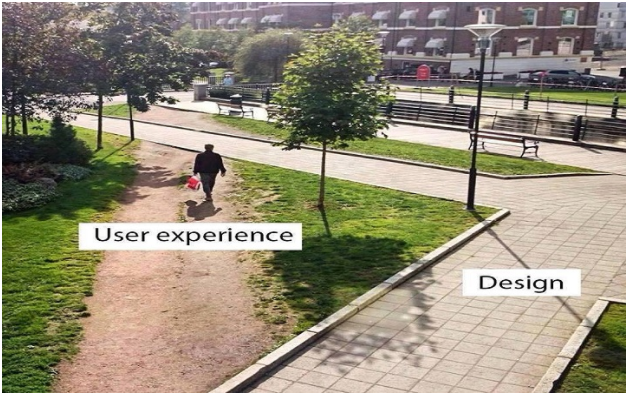
An example of what users do vs what you want them to do. Source .
How do I create a customer journey map?
Fundamentally, the best practices for your journey maps will vary based on the nature of your business, product, or service. However, the steps below will guide you through this process, regardless of your industry and product type.
1. Have an ideal customer persona (ICP)
A persona is a fictional representation of your customers that aggregate similar traits among them. Typically products have a few of them to accommodate for differences between user types. It is essential that every ICP has its own journey to avoid having a generalist approach.
Mapping the customer journey to a particular persona will allow us to create experiences that aren’t exclusively aligned with our assumptions.
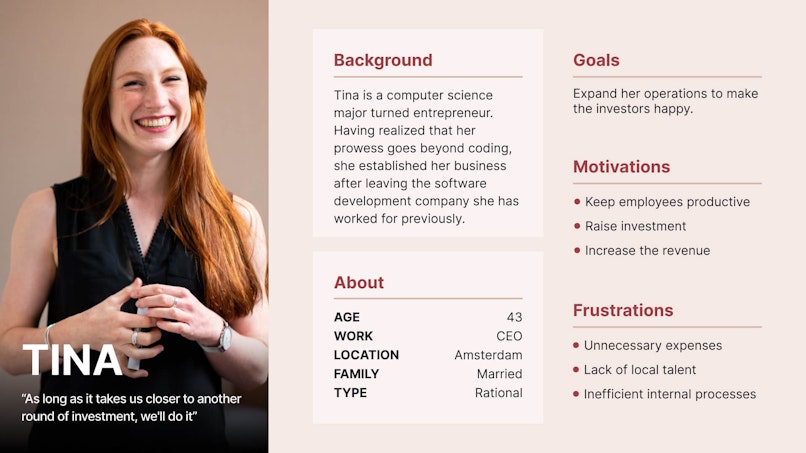
An example of a customer persona
2. Have a clear goal
Determine the goal of your journey. Without a goal, you’ll likely end up with a generic map that has little value. As a result, you’ll invest time in an asset with little practical application, which we want to avoid. Make sure that your journeys have clarity in terms of goals and direction.
3. Gather data
In case you haven’t had the chance to develop your personas, it’s vital to start aggregating data as soon as possible. There are plenty of tools that will help you better understand how your customers behave.
In case you don’t have tools like Google Analytics, Hotjar, or Mixpanel set up, it’s always a good idea to run user interviews . Such interviews provide a wealth of insight into your customers’ decisions and their journey.
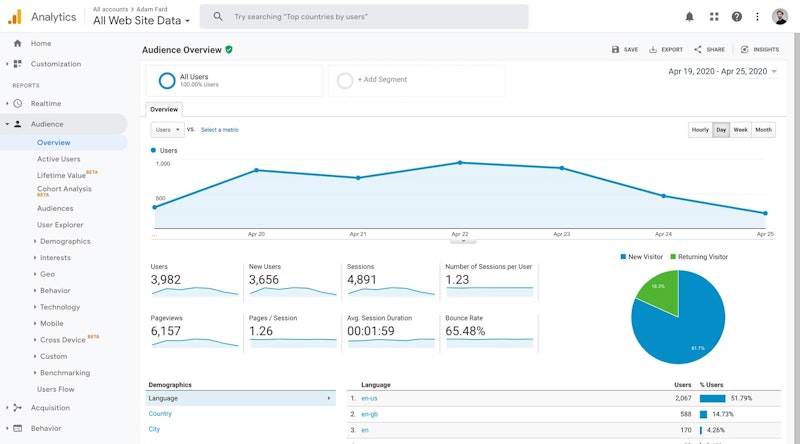
A screenshot from Google Analytics
4. Outline your touchpoints
Your customer journey map should consist of touchpoints — they are steps in your customer’s journey that take them to a particular goal. Touchpoints can go as far as the customer’s first interaction with your brand, whether it’s marketing material or your website.
Once you’ve identified your touchpoints, you can proceed to map, rethink, and improve them.
More importantly, you can always take a more granular approach and identify specific targets for every step of the journey. For instance, you can explore what goals, thoughts, and frustrations users might be prone to when interacting with specific touchpoints.
This information can then be used to populate and, subsequently, inform your customer journey map and design strategy.
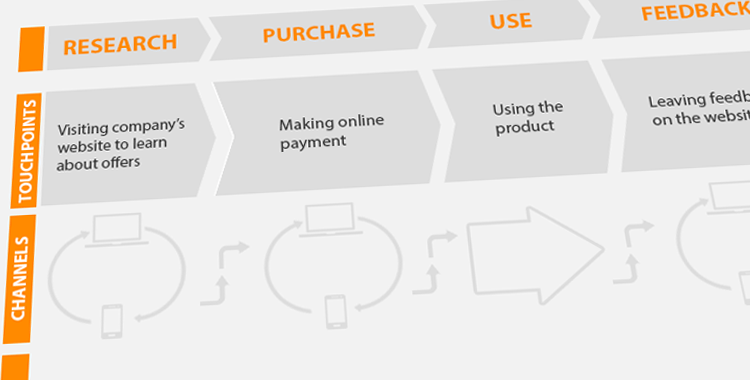
Handy tools
There is a wide array of tools that can help you create a detailed customer journey map. As the title of the article suggests, we’ve only listed tools that are free to use or have a free version that we’ve previously used and can vouch for.
Google Sheets .
This is one of the most straightforward ways of visualizing the entire customer journey. If you’re looking to create a quickly digestible representation that will help you understand the journey map — this is the way to go.
However, it’s also safe to say that Google Sheets is a fairly versatile tool, to begin with. So in case, you’d be interested in spicing things up visually, you’ll definitely be able to do that.
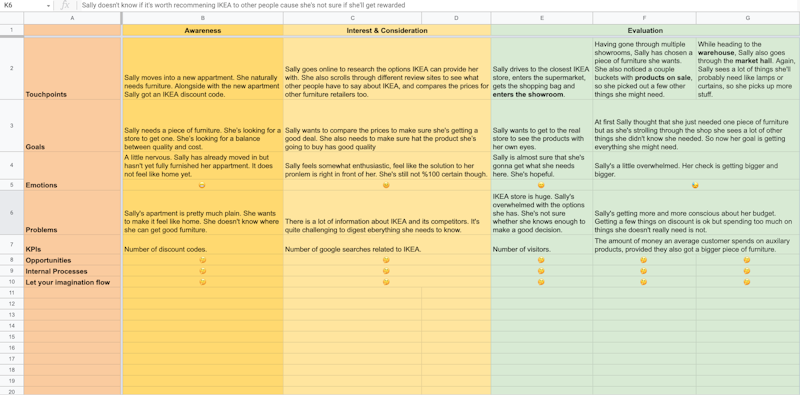
Here's the link to this spreadsheet.
Miro is a free mind-mapping tool — it has a fairly simple learning curve. It’s also versatile in how you present information. A cherry on top is that Miro allows real-time collaboration, making it an excellent environment for simultaneous work.
You can find a pre-built template here .
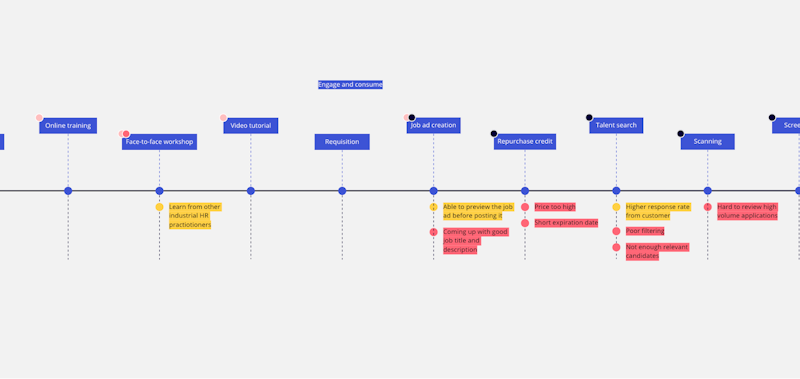
While Google Sheets is quite a versatile tool, Figma is on a whole other level in this regard. What distinguishes Figma from other tools is that it’s extremely flexible. Figma is free, by the way. The key downside is that the learning curve is pretty steep, especially if you have never dealt with Figma, Sketch, or a similar tool before.

Unlike the tools we’ve already mentioned, UX Pressia is specifically designed for creating customer journey maps. Therefore, compared to Figma, its learning curve is significantly more manageable. The only downside is that the free version enables you to create just one map. To create more than one map, you need to upgrade to a premium version. Pricing starts at $20/mo for a one-month subscription.
There’s no need for templates in this case, as the tool itself is pretty much a template for a customer journey map.
There’s no single right way to create a customer journey map. It all depends on your company, product, and service, as well as the customers you cater to. Despite that, there’s a variety of immutable principles that need to be taken into account when planning your customer experience.
The steps we’ve provided in this article should help you craft a meaningful customer journey map that will understand their needs .
Make sure you have an ideal customer persona to address your users’ pain points and preferences;
Have a clear goal when developing your journey map;
Leverage data to inform your decisions during journey mapping;
Outline your touchpoints to better understand your customer;
Don't forget to share this post:
Need help with boosting metrics?
We can help you resolve usability, retention rate and conversion issues through impeccable UX.
Related Stories
Explore ai writing tools: a quick guide.
Curious about how AI writing tools can transform your writing? These tools leverage cutting-edge AI to enhance creativity, ensure error-free grammar, and streamline content production. Whether you're working on marketing materials, academic essays, or captivating blog posts, our guide delves into the seamless integration of AI tools with SEO tactics, improving productivity and sparking innovation in content creation. Dive in now and start revolutionizing your writing!
AI in Business Intelligence
Curious about how AI in Business Intelligence is changing the game? Dive into how advanced analytics, machine learning, and natural language processing are not just buzzwords but real tools reshaping strategic decision-making and operational efficiency in the business world. Let's explore the transformative journey of AI-driven BI tools together.
AI in Business Operation: Maximizing Efficiency
Discover how AI in business operations is revolutionizing efficiency and innovation, from predictive analytics enhancing supply chain management to AI-driven tools transforming customer experiences. Explore the transformative power of artificial intelligence as it reshapes decision-making, operational streamlining, and customer engagement across industries.
Exclusive UX Articles & Strategies
for Startups, UX Designers & Entrepreneurs
Learn how to rank #1 on Google.

Raechel Duplain Group Manager, Solutions Marketing
5 Customer Journey Map Examples

Want more resources like this?
Sign up for our weekly newsletter for content like this delivered straight to your inbox.
Sign up for The Local Digest
The Local Digest is our weekly newsletter full of tips and tricks to help local businesses grow.
Secure more leads for your business today
Outrank your competition on Google.
Get started now
Ready to grow? Grow and scale your business with an all-in-one lead management platform.

IMAGES
VIDEO
COMMENTS
Definition: A journey map is a visualization of the process that a person goes through in order to accomplish a goal. In its most basic form, journey mapping starts by compiling a series of user actions into a timeline. Next, the timeline is fleshed out with user thoughts and emotions in order to create a narrative.
Journey maps visualize the process that a user goes through to accomplish a goal. They provide a holistic view of the customer experience, highlighting both positive and negative moments from the user's point-of-view.. Leading a journey-mapping initiative is no small challenge. It takes product knowledge and research savvy, along with project- and stakeholder-management skills.
Define the map's scope (15 min) Ideally, customer journey mapping focuses on the experience of a single persona in a single scenario with a single goal. Else, the journey map will be too generic, and you'll miss out on opportunities for new insights and questions. You may need to pause creating a customer journey map until you have defined your ...
Journey mapping yields the following benefits: It enables you to identify whether (and where) you may be confusing customers. It provides an understanding of what information you are transmitting to customers at their various points of interaction. It uncovers stress and failure points on the customer's typical path.
5. Map the customer journey. Illustrate the user journey by mapping these touchpoints on a visual timeline. This creates a narrative of users' reactions across your entire service blueprint. To represent your users' emotional states at each touchpoint, graph their correspondences like this:
In addition, most practitioners (64%) reported creating the journey maps collaboratively, with 34% collaborating over physical tools (e.g., sticky notes and paper) and 30% using digital tools (e.g., Miro, Mural, Google Sheets). In contrast, 36% reported creating the map as a solo activity using either physical tools (10%) or digital tools (26%).
A customer journey map visualizes the steps a potential customer takes before and after purchasing. It organizes marketing activities into phases, providing clarity amidst complexity. Not all interactions aim for immediate sales; some move customers closer to future purchases.
A customer journey map can prove invaluable for optimizing across multiple departments—marketing, sales, product, and customer service—in many, many ways. Mapping your customer journey can help you: Promote a customer-centric culture internally and externally. Identify your ideal buyer and connect with customer needs.
In a single illustration, the journey map aims to capture the entire customer experience. No small task. Done well, they empower people to work cross-functionally and iron out all of your customer ...
A customer journey map, also known as a user journey map, is a visual representation of the path a user takes from beginning to end in accomplishing a specific goal with your product. The backbone of a customer journey map (CJM) is a timeline of sorts, following the succession of touchpoints (thinking here of Moments of Truth and micro-moments ...
A customer journey map is a broader view of the entire customer experience across multiple touchpoints and stages. It considers physical and digital channels, multiple user personas, and emotional and qualitative aspects. A user journey map is a detailed view of the steps to complete a specific task or goal within a product or service.
That's a good thing because a journey map is always tailor-made. Which parts you add to your journey map depends (just like the type) on the goal, but broadly speaking, a journey map contains four basic parts. To clarify this, we will use the customer experience of a fictional customer journey. 1. Scenario.
A journey map is a holistic, visual representation of a user's experience with a product or service over time. Journey maps combine data and insight from other research and discovery methods to provide a detailed description from the user's point of view of steps taken, decisions made, successes, pain points, and emotions felt.
It's simple, professional and to-the-point, and covers all the basic elements that need to go into a journey map. 2. Gaming Customer Journey Map Template. This gaming customer journey map template is created with recreational mobile apps in mind, but you can use it for any tech, SaaS or other industry.
A customer journey map helps you gain a better understanding of your customers so you can spot and avoid potential concerns, make better business decisions and improve customer retention. The map ...
The chart below shows the steps for using a journey map to create a new product or service. Guidelines at the end of this section describe how to use the journey mapping process for an existing product or service. Step 1. Establish the Design Goal for the Product or Service.
The journey map exercise is focused on the customer experience with your organization so it is critical that all members of the organization that interact with customers participate in the exercise. This might include: members of the call centre or customer service. marketing team members. persons responsible for analytics review and monitoring.
An outdated journey map may be worse than no journey map at all. With the accountability teams in place, be sure there is a regular audit or mechanism whereby data and assumptions are updated regularly. ... Customer Analytics For Dummies Quantifying The User Experience: Practical Statistics For User Research 3300 E 1st Ave. Suite 370 Denver ...
Step 4: Implement your customer journey map and conduct research. First things first, though: create a visually-appealing customer journey map that is accessible for all necessary team members. A graphic designer can help compile your findings and touchpoints in a visual sequence that is understandable, logical, and beautiful.
The only downside is that the free version enables you to create just one map. To create more than one map, you need to upgrade to a premium version. Pricing starts at $20/mo for a one-month subscription. There's no need for templates in this case, as the tool itself is pretty much a template for a customer journey map.
User experience mapping can help you significantly improve the customer journey even before you start prototyping it. It helps you think from your user's perspective and visualise the friction you have in experience. Addressing these issues helps you create a super awesome product that your real customers want to use.
Customer journey mapping is crucial to the customer experience. Here are 5 templates you can try. Customer journey mapping is crucial to the customer experience. Here are 5 templates you can try. Learn how to rank #1 on Google. Get your free report. Sales: 1-801-438-4425 Sign In Watch a demo Take a tour.
The idea of an employee journey map has roots in the customer journey map — a visual document that charts the customer experience as it progresses through the stages of a company's sales-and-marketing funnel into a buyer/seller relationship to achieve goals for the customers.. The customer journey map for service design was first introduced by the (then up-and-coming) international design ...